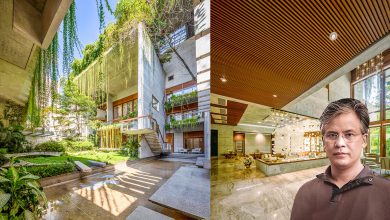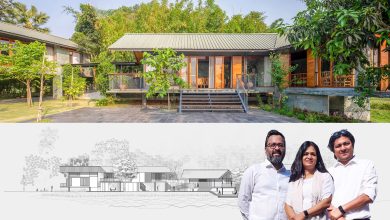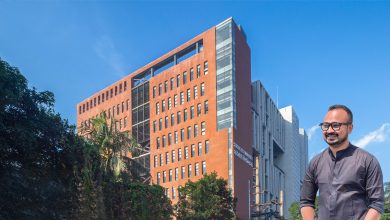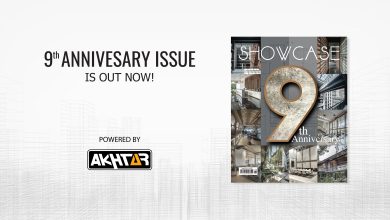Concord Kabir Tower, Gulshan 2
Revamping the image of an apartment building, Concord Kabir Tower in Gulshan 2 delivers a desirable lifestyle for its inhabitants. The residential project of 28 apartments of 3400 square feet, with less than 50% ground coverage allowed to play around with volumes and bring out spaces such as the lawn, green terraces, and double-layered rooftop garden. With its elegant outlook, garden experiences, wide rooftop view, and various amenities, Concord Kabir Tower stands as an example of how abiding rules helped to elevate the design of comfortable living without incurring a loss as many presume.
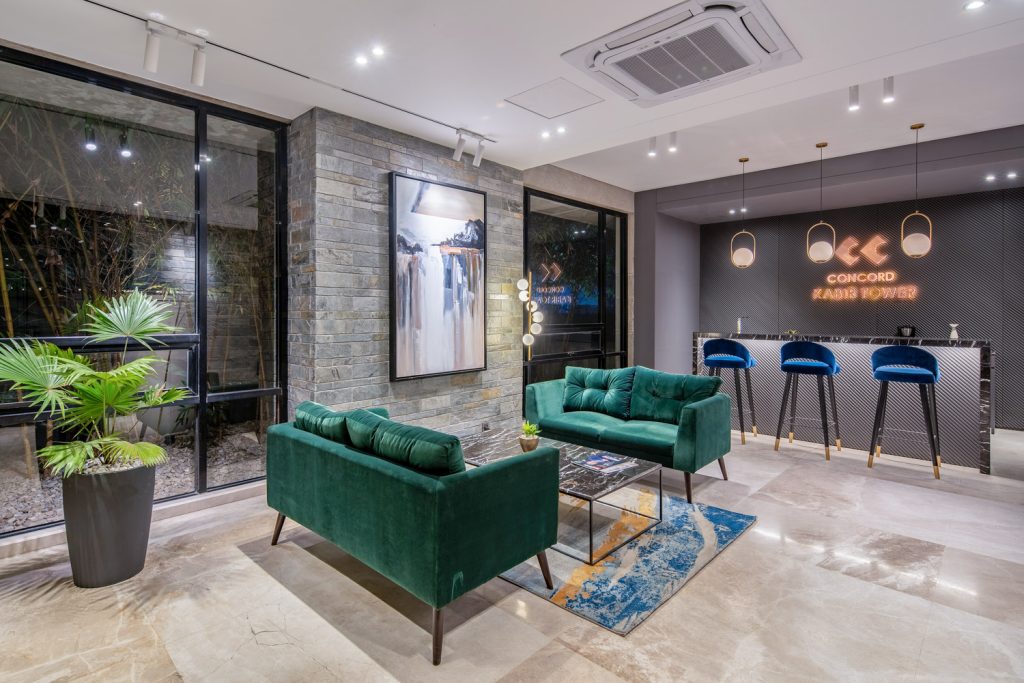
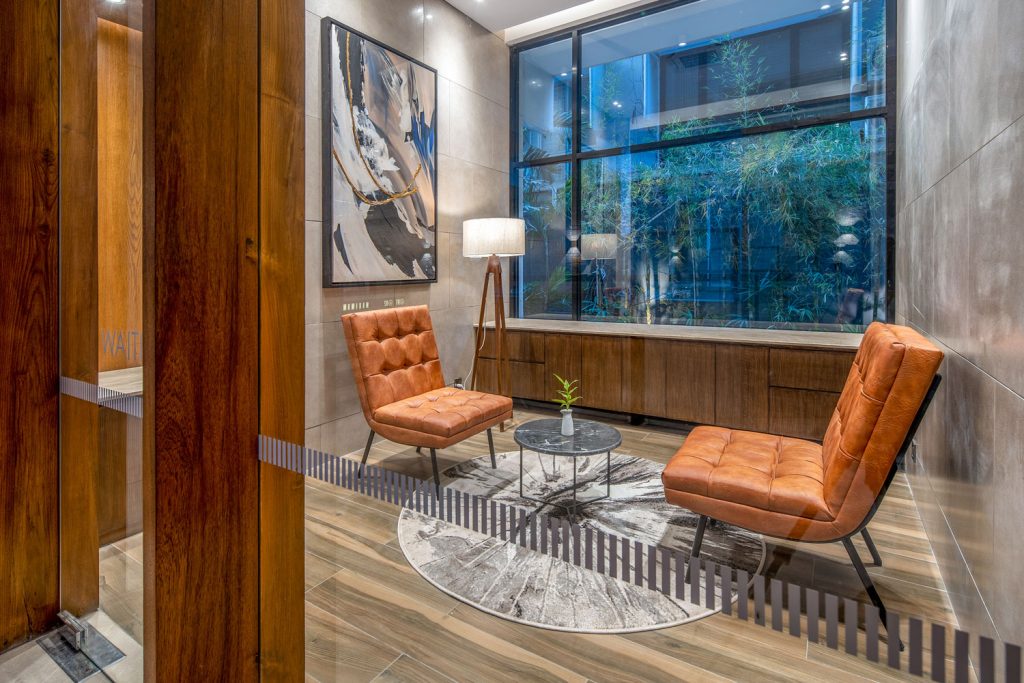
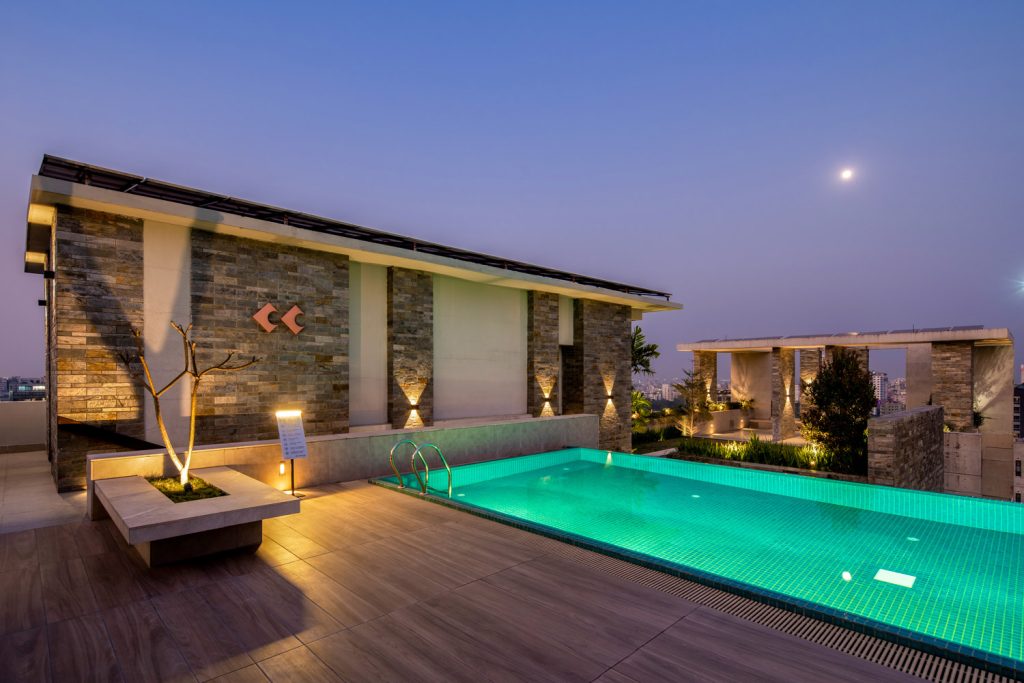
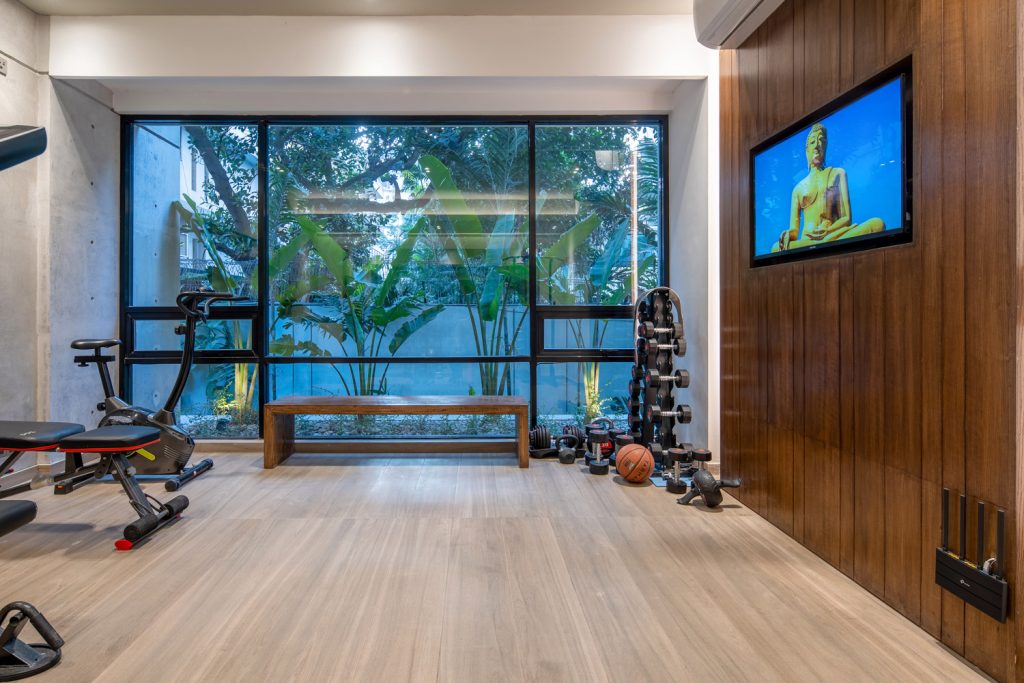
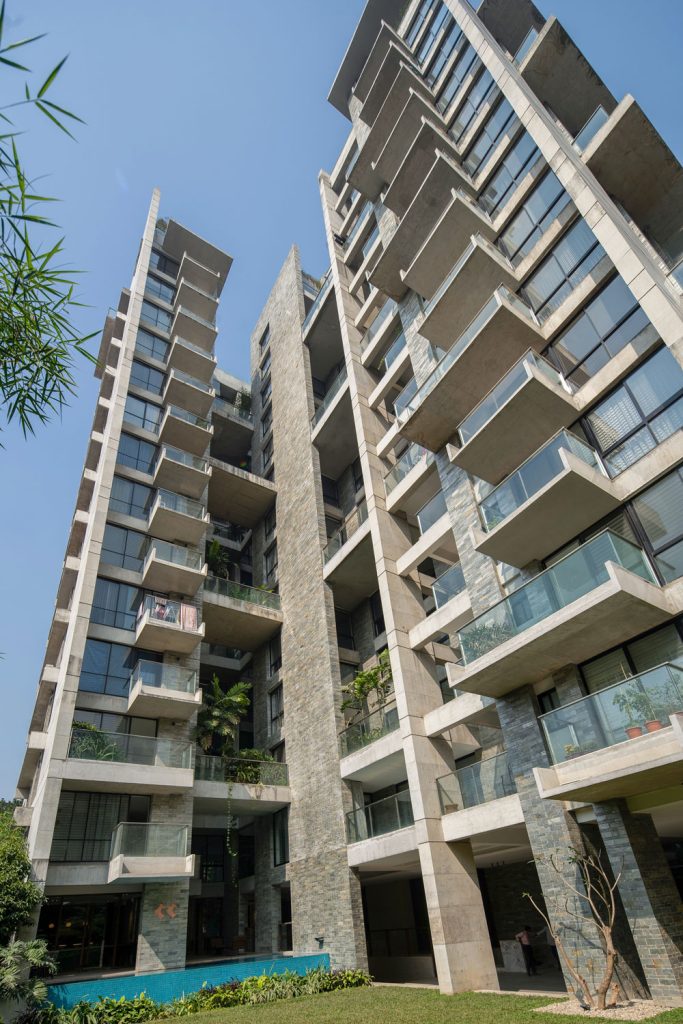
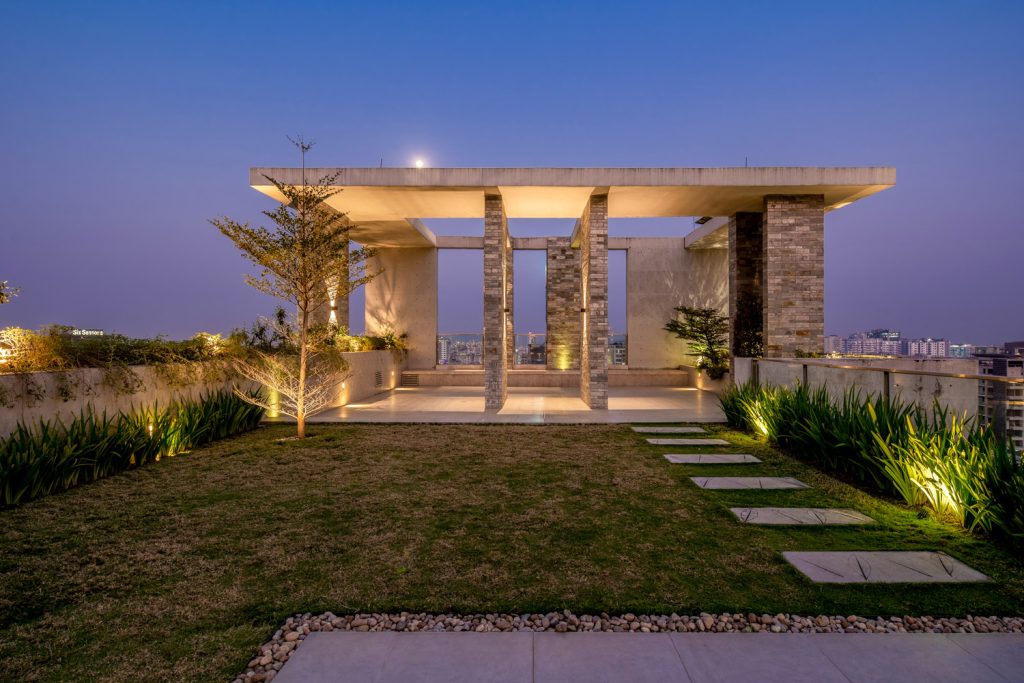
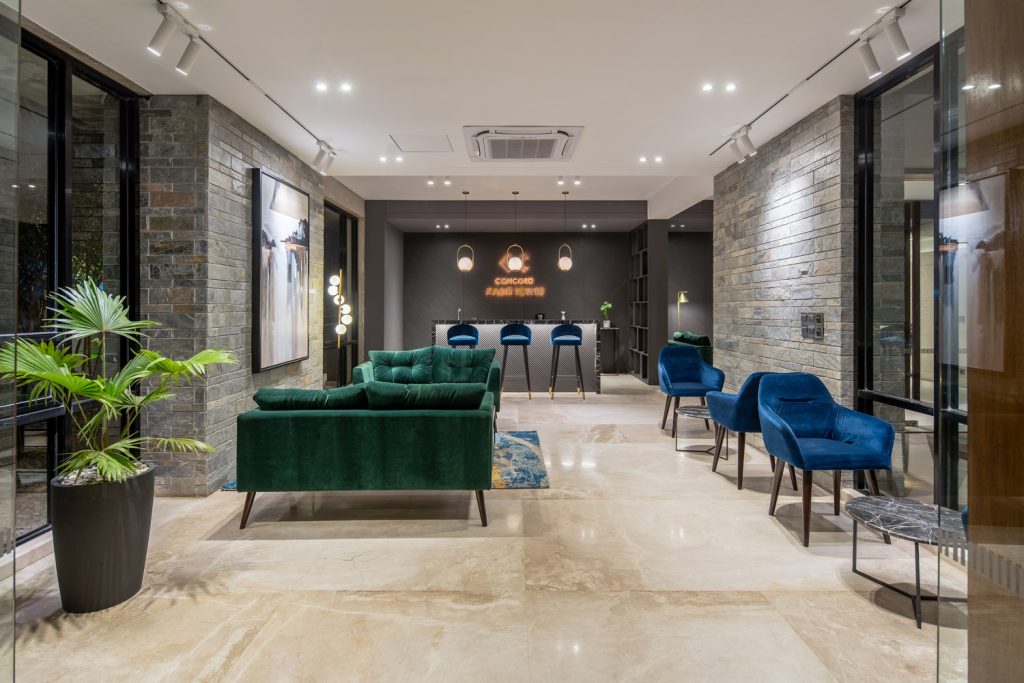
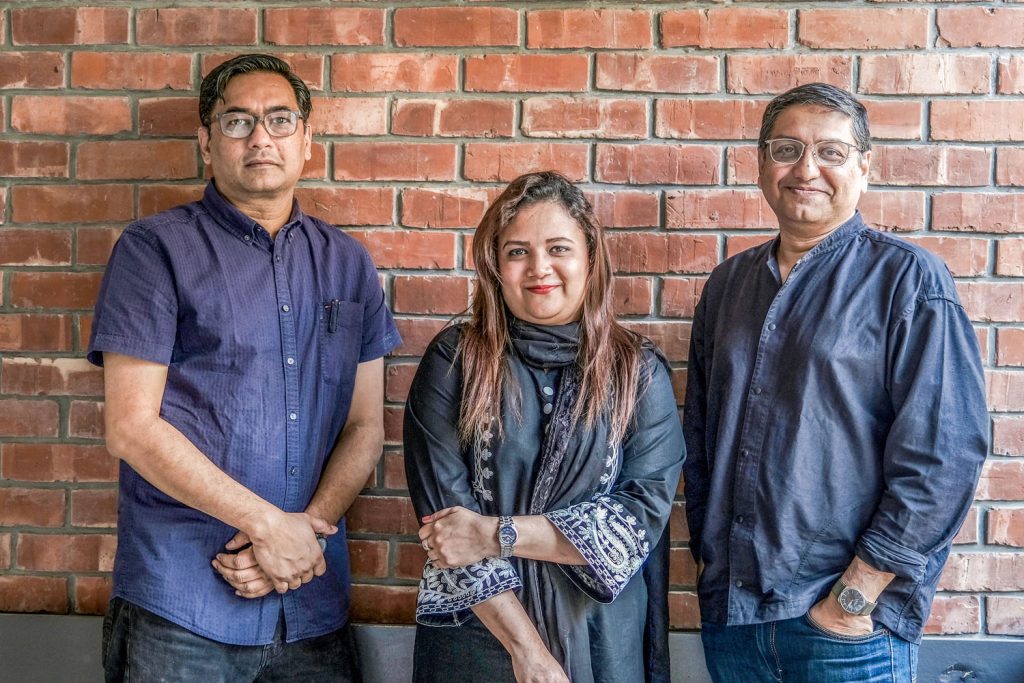
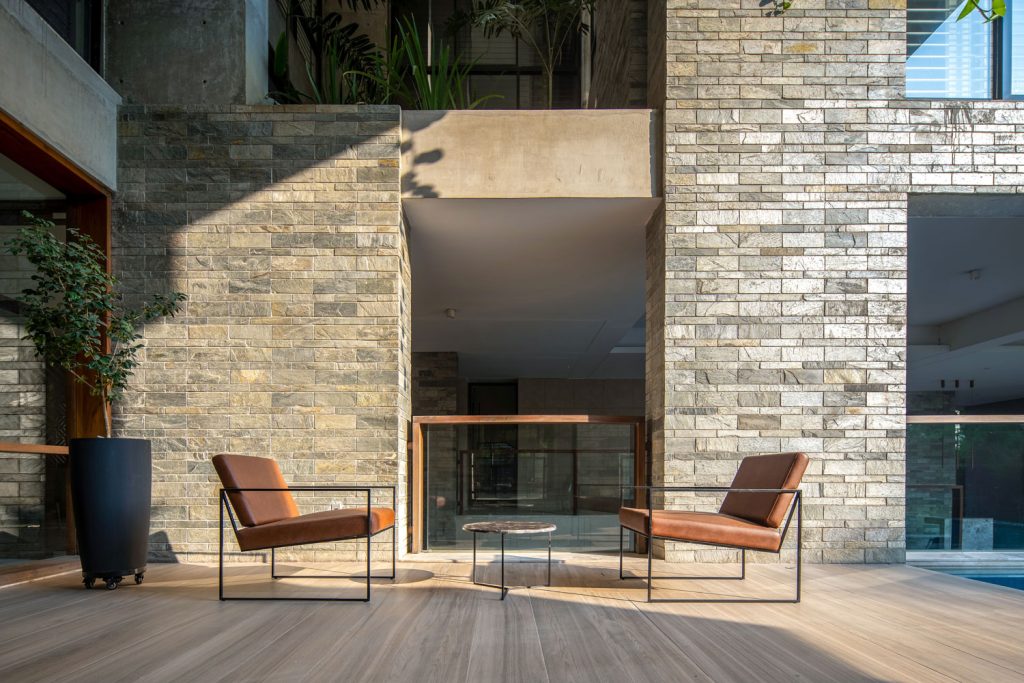
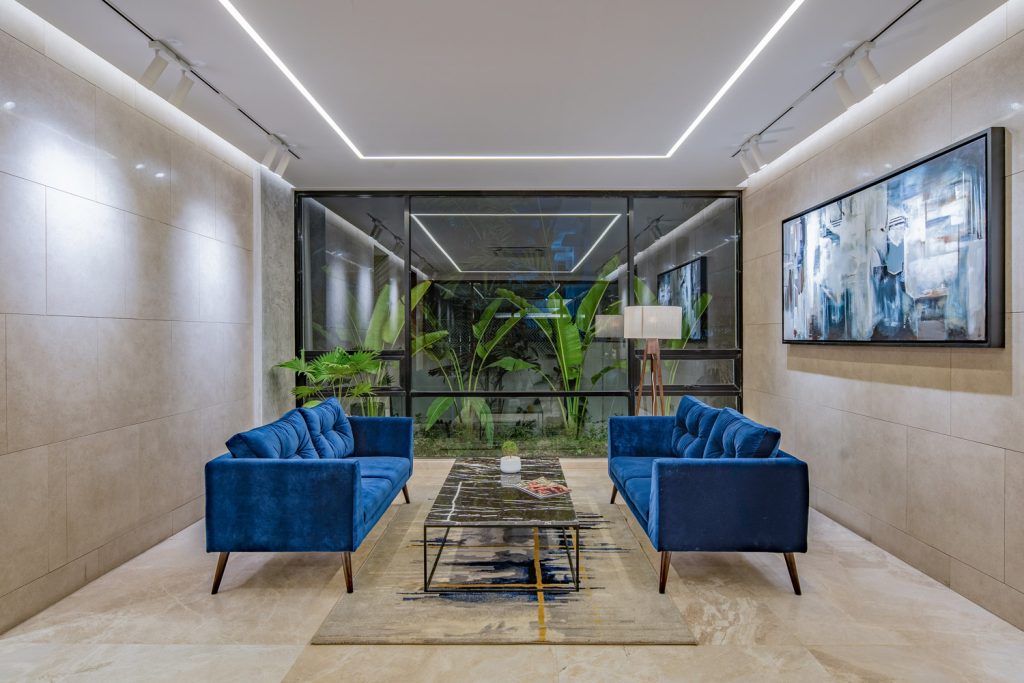
Concord has been a pioneer developer company since the late eighties and is moving forward with time to break out from the old stagnancy alongside working with consulting architects. As the Managing Director, Shahriar Kamal described, they wanted the condominium to provide the inhabitants with their desired lifestyle while complying with RAJUK rules and building codes. The design of the functional building was well solved with a lucrative aesthetic aspect as well and aimed to feature convenient living for the residents. The L-shaped linear form of the building, centering around the lawn, faces the southeast side, opening up to the pleasant morning light and avoiding the heat of evening time. In line with Renzo Piano’s philosophy to have large windows and a minimalist approach to lighten the impression, the linear concrete structure allows light and ventilation evenly throughout the space through the open glass windows. The one-directional column structure with shear-wall open scope for wide aperture along the North-South facade. Environment-friendly slate-stone cladding is used on the infilled walls of the facade along with the main elements consisting of concrete and glass.
The community space is divided into two parts. One is on the ground level with the green lawn and waiting and party lounges with all facilities, and the other is on the rooftop that features a reflecting pool and BBQ zone. The project was designed by Ar. Mahmudul Anwar Riyaad, Ar. Mamnoon Murshed Chowdhury and Ar. Shaoki Shamim while the in-house team of Concord executed by Faisal Ahmed and Md. Kamrul Hasan Akhand, addressed the design style by prioritizing comfort and making it capable of awing the visitors with their first impression and is nothing less than something that can be seen abroad. While the common spaces are adorned with a neutral colour palette with a modern-minimalistic approach to its interior, the residents are given the freedom to design their own or opt for a proposed standard one. The architect understood that the same plan layout can give off a different vibe according to the personality of the inhabitants and thus aimed for flexibility while space segmentation.
The prominent overlapping terraces, the open green terraces that are accessible from various apartments, and the lawn have trees around the defining edges. The trees are chosen so that they can be easily sourced and maintained, as they might be unattended due to a lack of ownership. The placement of the trees unfolds the area for sports and other activities. The green connecting spaces defy the practice of living apart in apartments and bring the community together.
Text by Ferdoushi Hossain Suhi
Photography by Maruf Raihan
‘Kakoli Manor’ Residence, Bashundhara
Grounded in the values of contemporary design, the ‘Kakoli Manor’ designed by architect Faisal Ahmed demonstrates a commitment to the definitive architectural principles of space, light, and proportion. The result emanates an overall feeling of clarity and composure – a home that enhances the life of the growing family who resides within its walls. The residence equally emphasizes street presence and surrounding vistas of the Bashundhara residential area to where it locates.
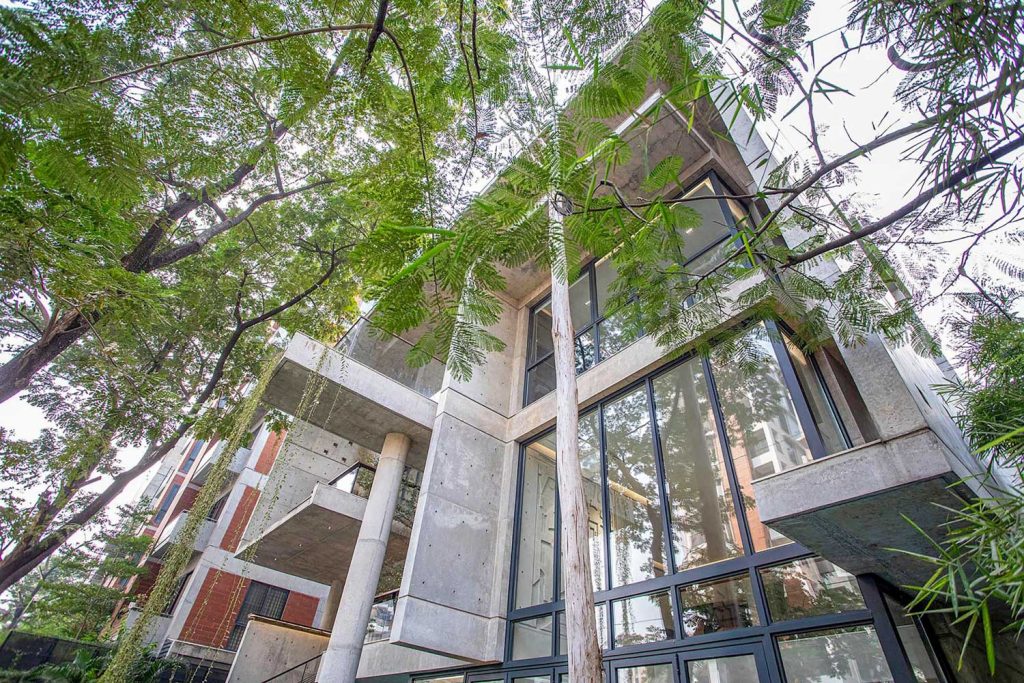
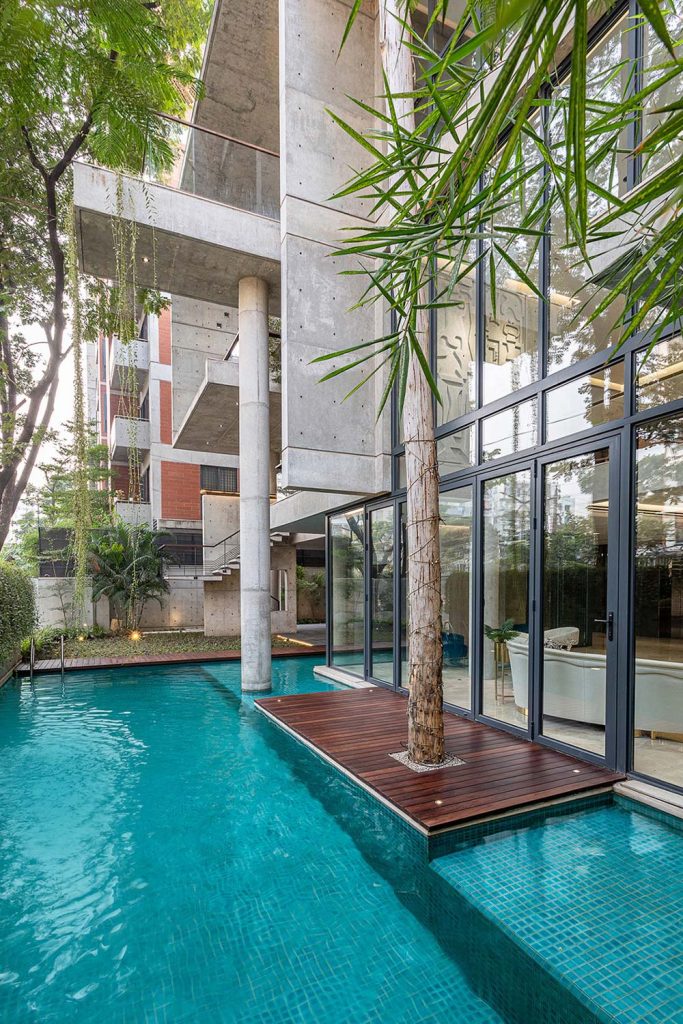
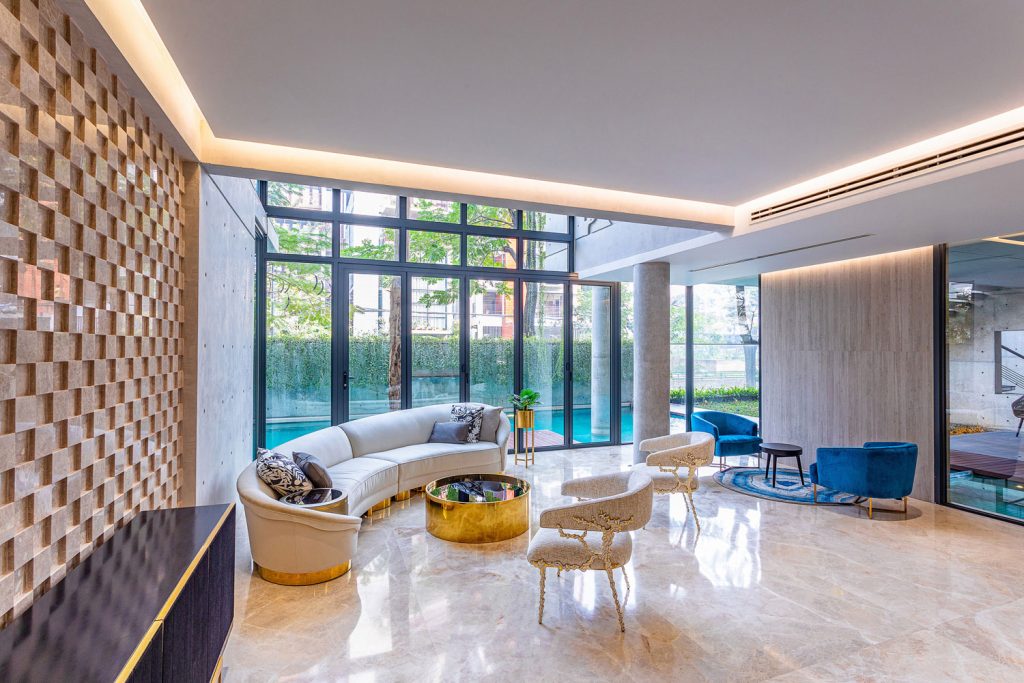
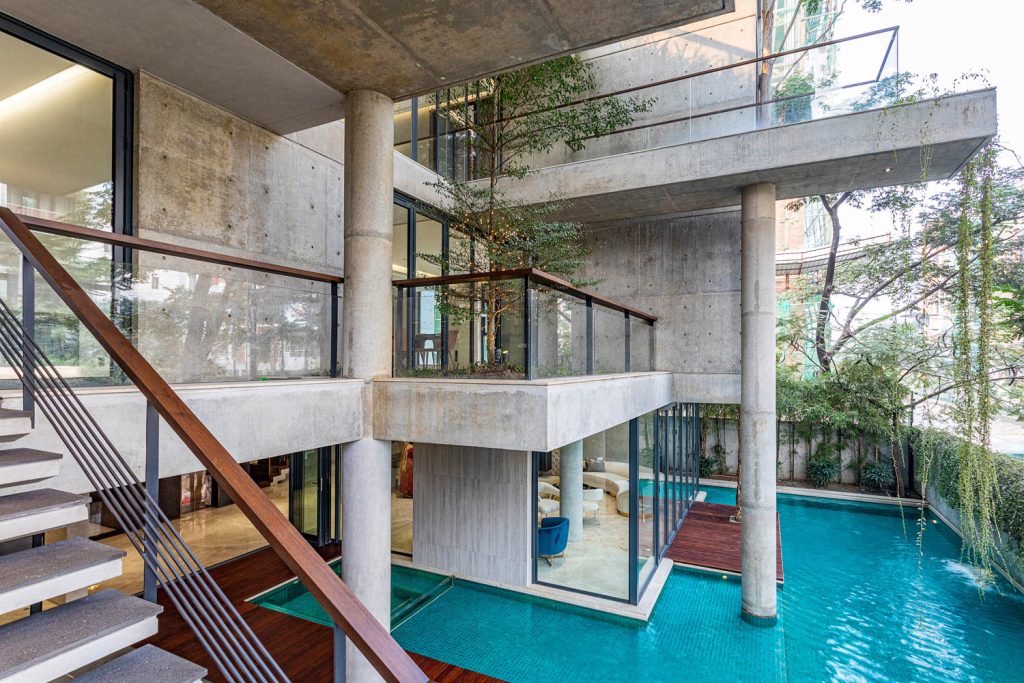
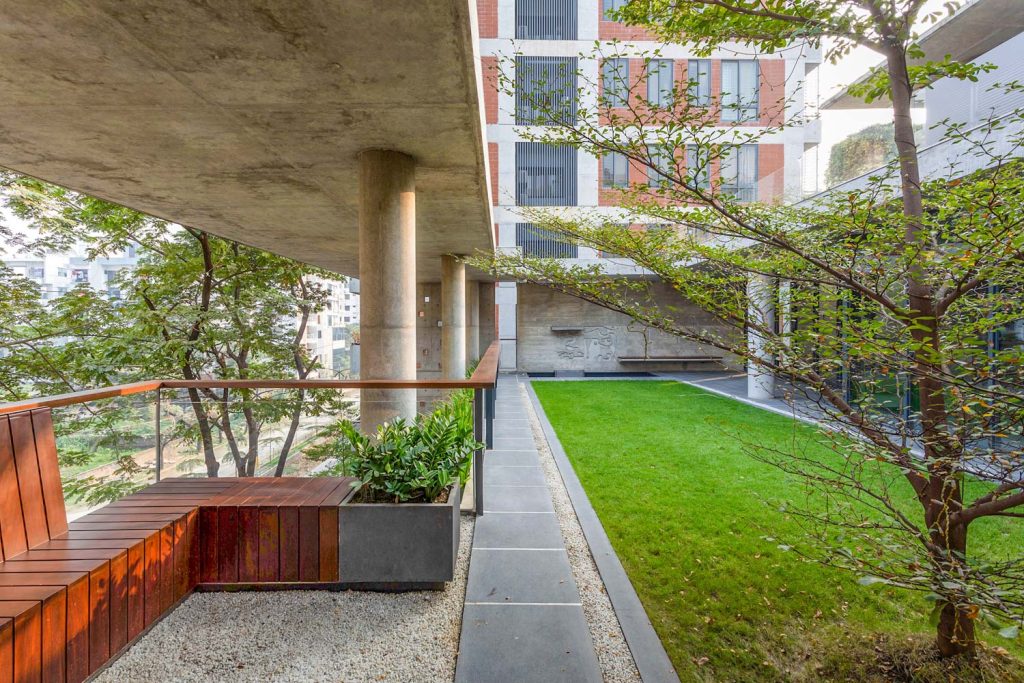
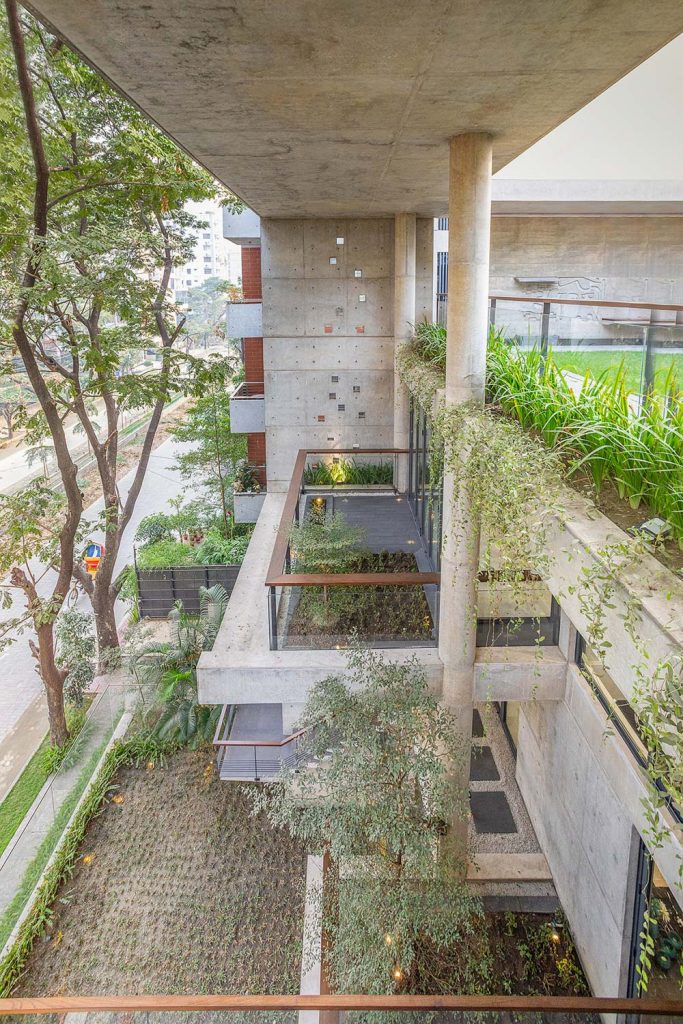
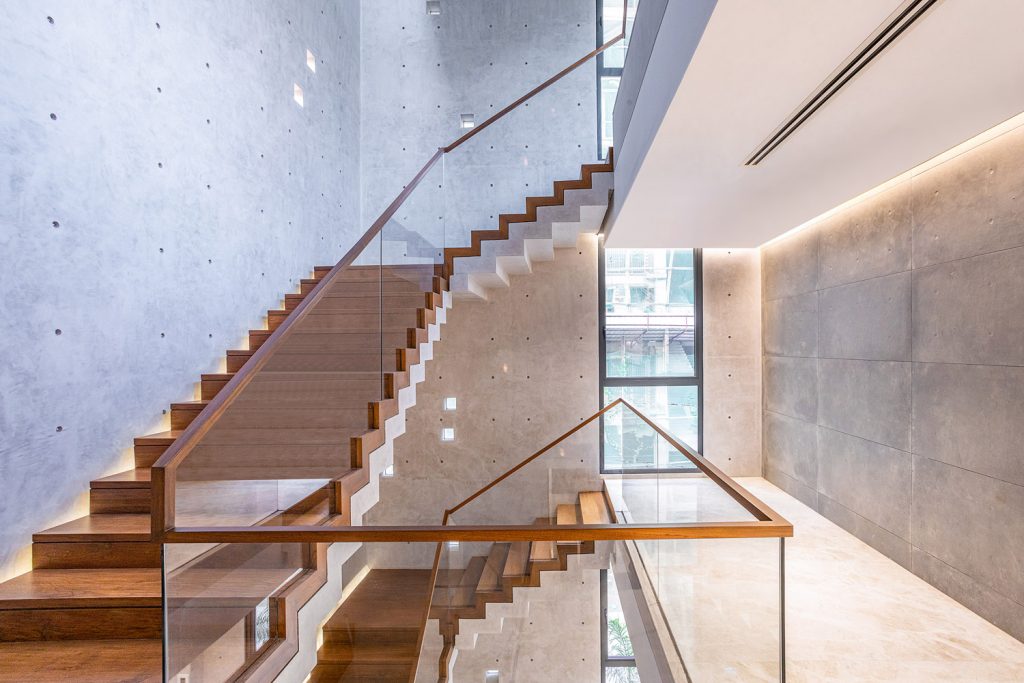
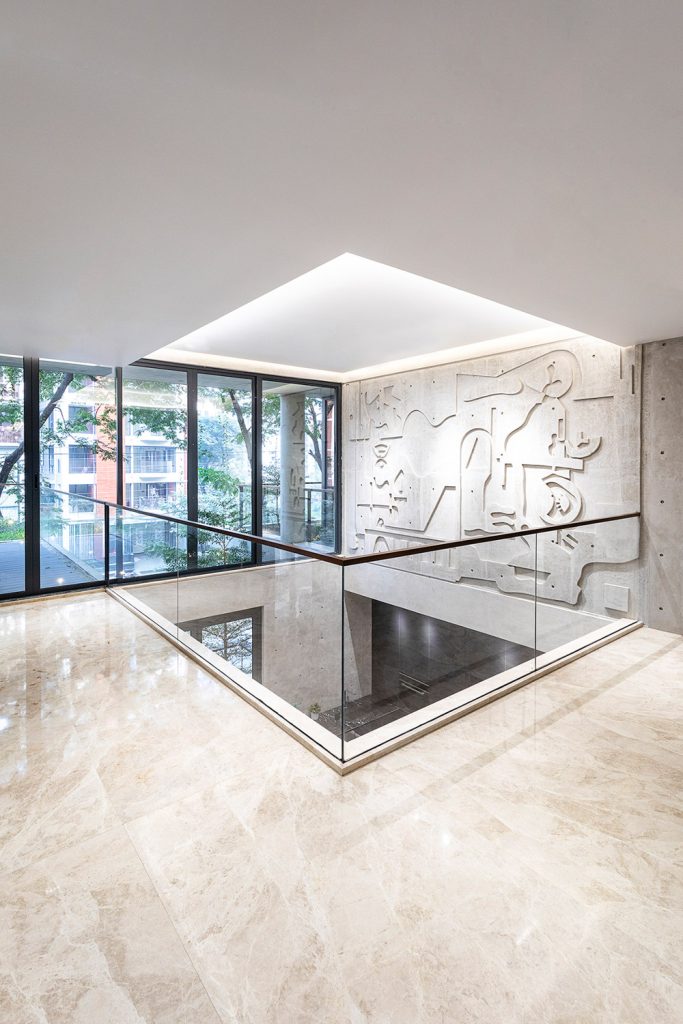
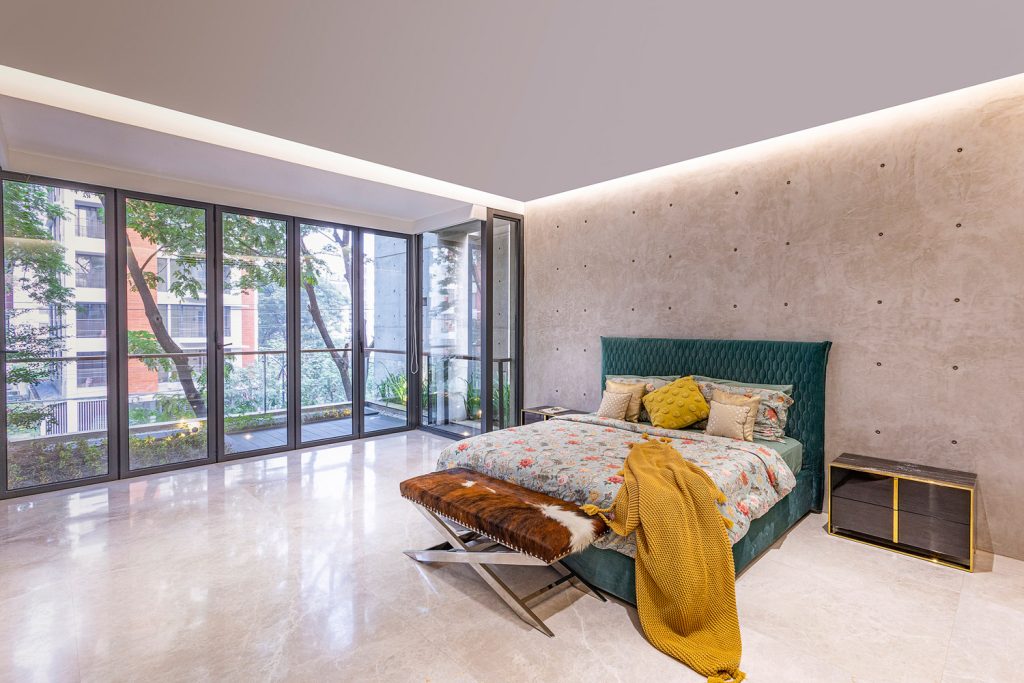
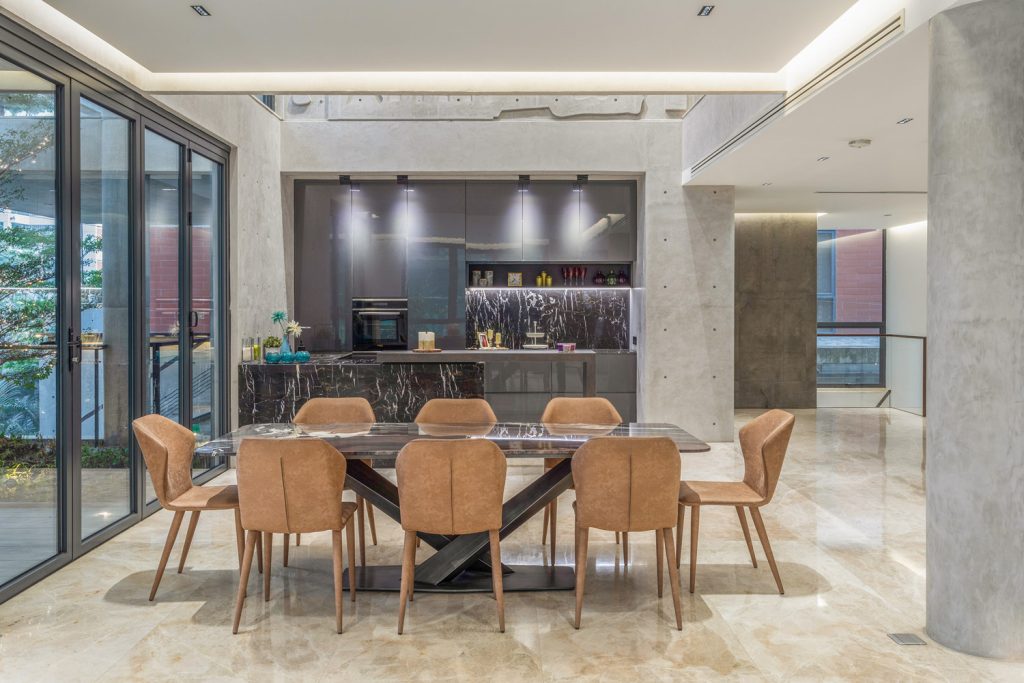
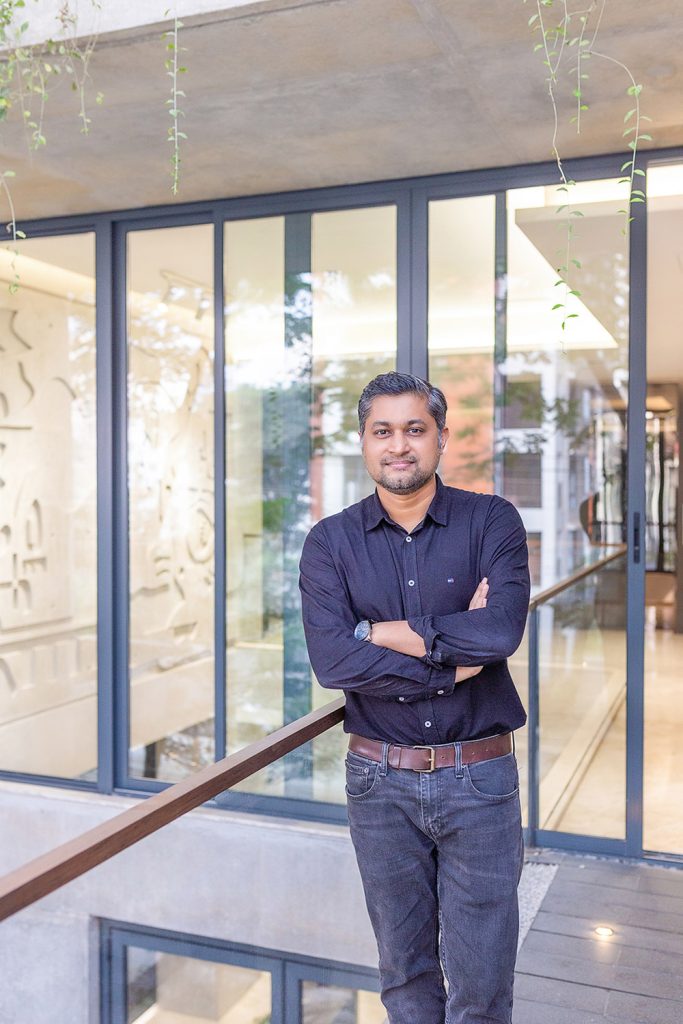

From the architect, various parameters lead the concept of the design, from the site’s orientation, air-movement to the choice of material to the integration of vegetation and light. The design team has worked on this project inside out, sculpting spaces according to form and function while allowing each material to create the requested atmosphere. Mrs.Kakoli Milon, the owner of the house, desired a home that is generously open, airy, and bright. It was achieved by a careful articulation of the plan, which is kept fluid, with vast open spaces that helped in creating an open ambiance, full of natural light and greenery. The residence is spread over three stories, offering different experiences with its surrounding environment. The ground floor expands to the outdoor pool and garden. It also hugs green lushes and trees adopting them as part of the house. The ground floor is a public zone consisting of formal living and dining areas. Furniture items are delicately placed benefiting from natural views and proper daylight.
The first floor is where the residents spend most of their time. It comprises a family dining and a coffee bar area, two separate kitchens, a TV room, and a sufficiently big walk-in closet room essentially designed for the boss lady of the house. The second floor is a private zone consisting of two bedrooms for the children and one bedroom for the parents, each opening to a terrace. The rooftop contains a gym, an indoor lounge, and elegantly furnished outdoor seating areas. The landscaping in the terraces and external areas is of predominantly tropical, low-maintenance species, creating a lush tropical feel inside the spaces.
The project creates connection throughout the rooms, expands the visual contact with the surrounding natural environment, and promotes new dynamics of the ever-changing play of light inside.
The result is an all-season escape space in the city with its qualified, airy, bright ambiance. The home’s three-story staircase is conceived as a sculpted element of the house. With a skylight aperture above, the stair is a vehicle for light entry and vertical engagement, illuminating as an artistic presence to each level.
The project is entirely built in concrete and used in its natural state giving an earthy tone. Interestingly, stretching one part of the interior wall is engraved in a graphical motif that brings out the details and beauty of concrete; especially, when light falls on the three-dimensional, textured natural finish, the phenomenon redefines the simplicity and minimalistic beauty of concrete. “During construction, we often lack technical difficulties. We are not ‘technically sound’ yet. Further, if it is a fair-faced building we need to put in extra effort to get the desired finishing. We got immense support and flexibility from the client throughout building this project made our design implementation easier”, shares architect Faisal Ahmed.
Text by Tasmiah Chowdhury
Photography by Rezwan Kobir Zoha & City Syntax
Kamini Residence, Notun Bazar, Dhaka
The predominant tendency to ignore environmental needs during housing expansions, increasing overpopulation and unplanned urban development have placed human beings and nature on opposing forefronts. The architecture firm, Group of Architects and Thinkers (GOAAT), aimed to bridge this chasm through the redesign of the Kamini Residence situated in Notun Bazar, Dhaka. In charge of the architectural components were Md Rabiul Islam and Nehleen Chowdhury, while the design team consisted of Abdullah Al Mukit and Kamrul Islam.
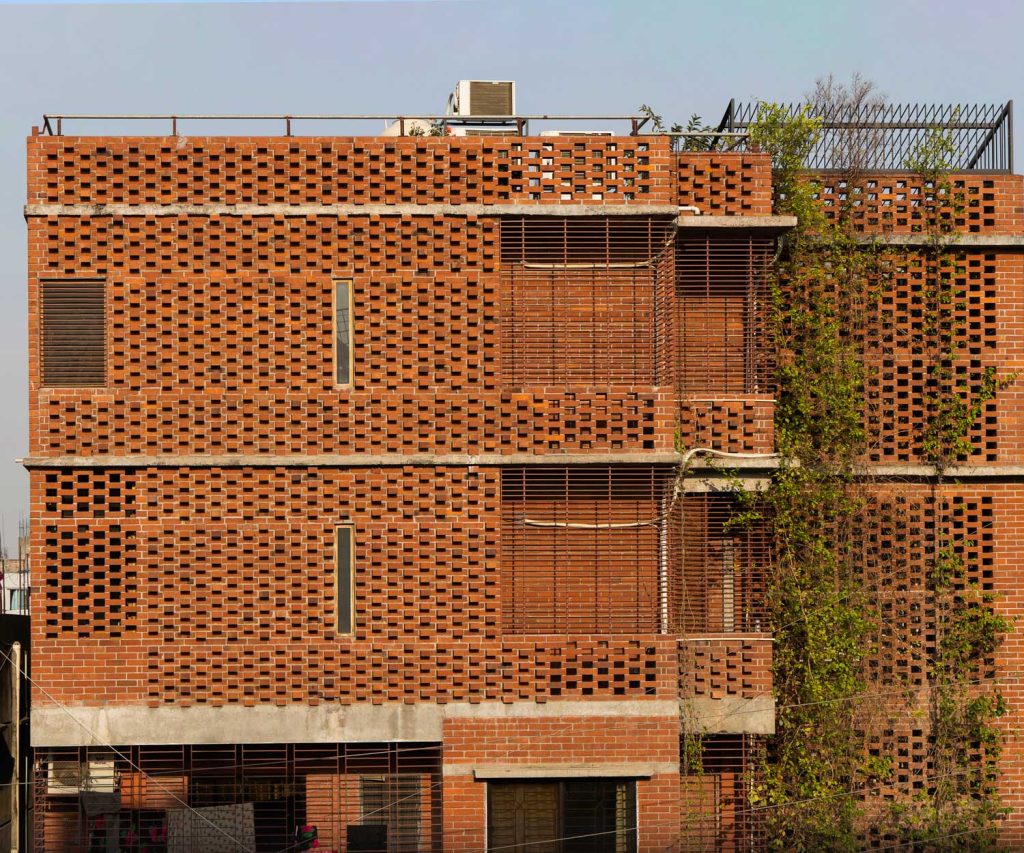
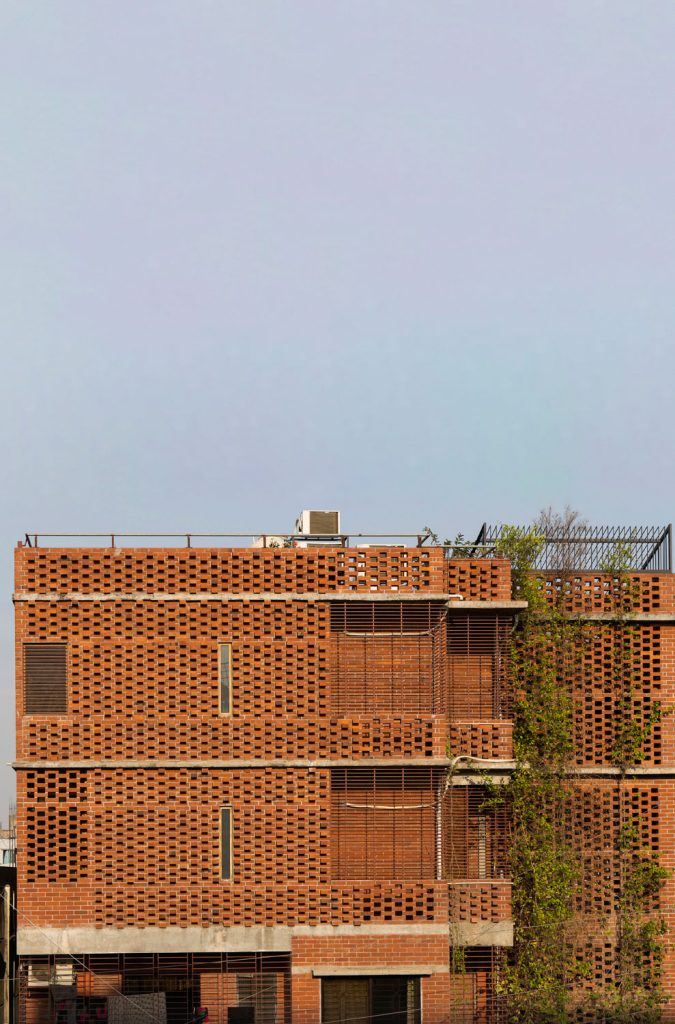
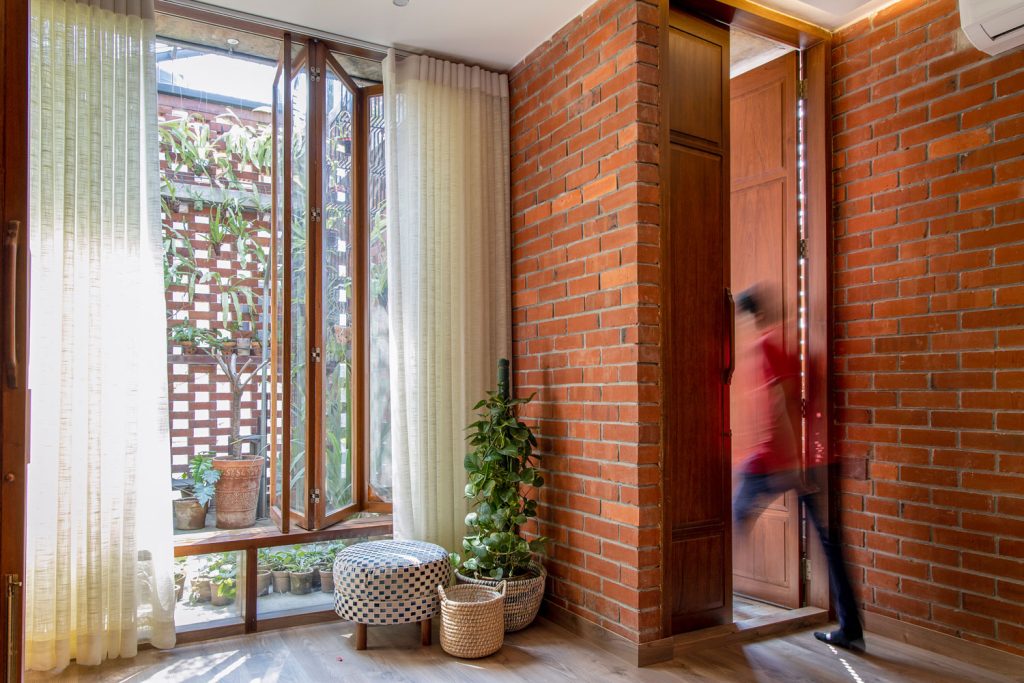
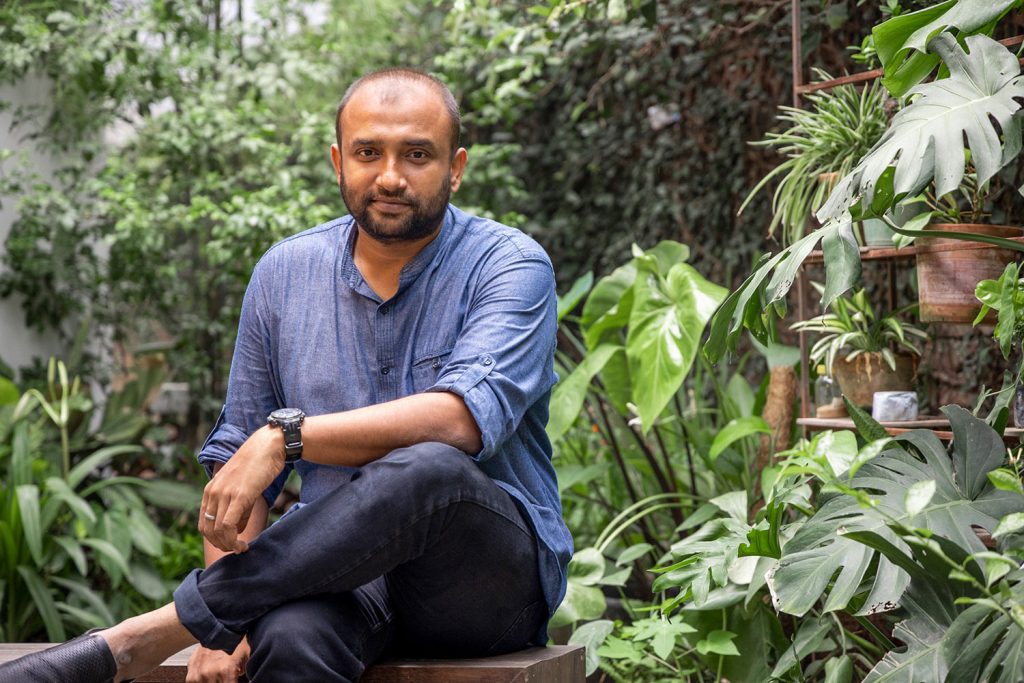
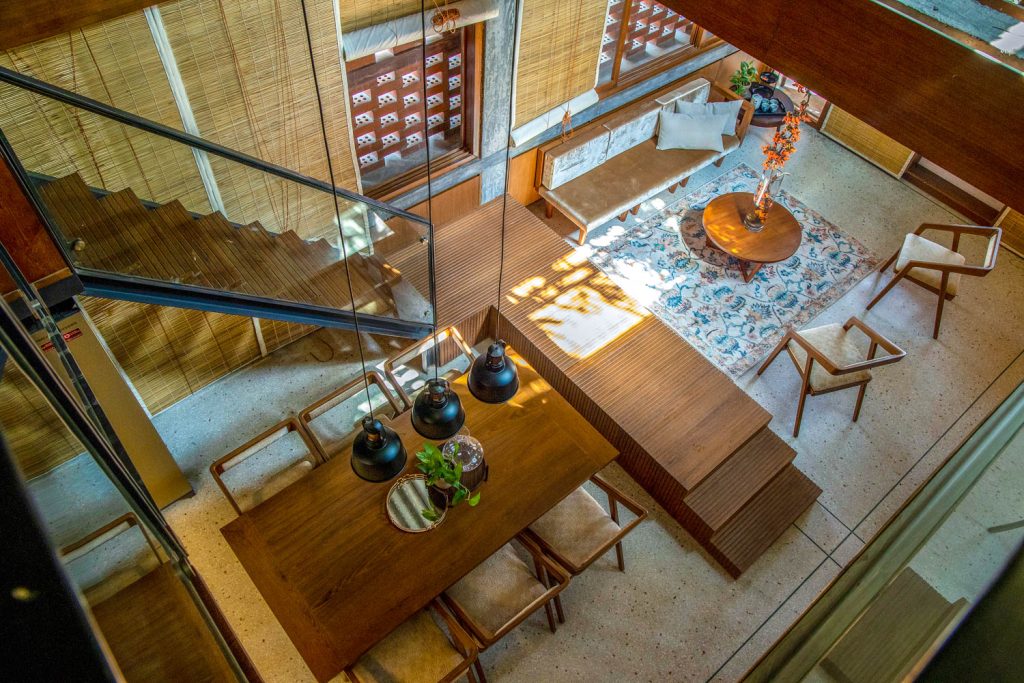
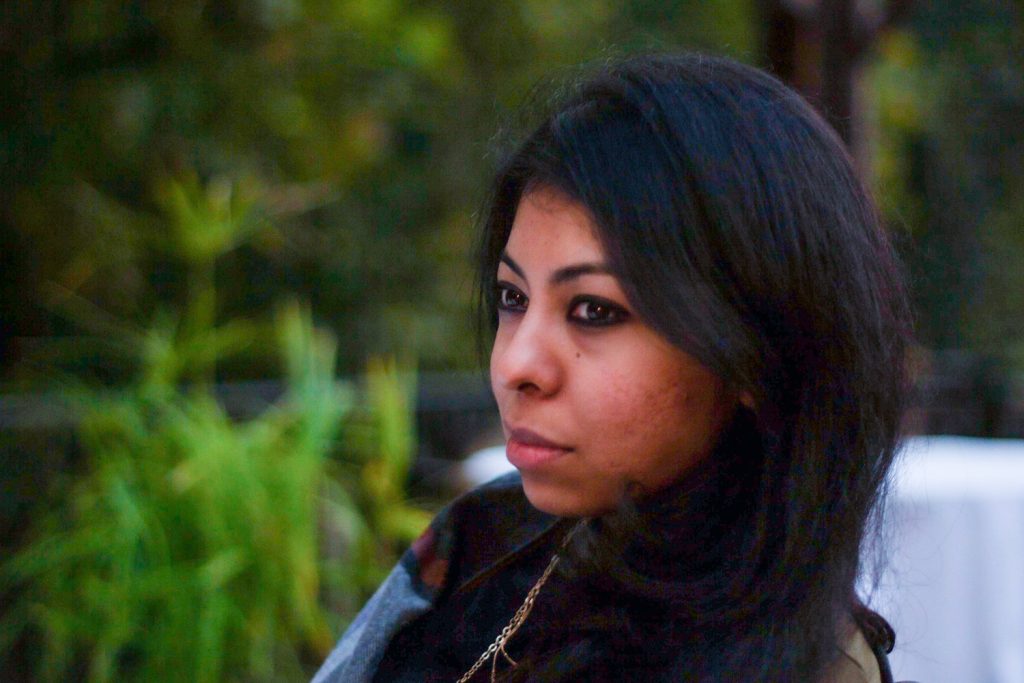
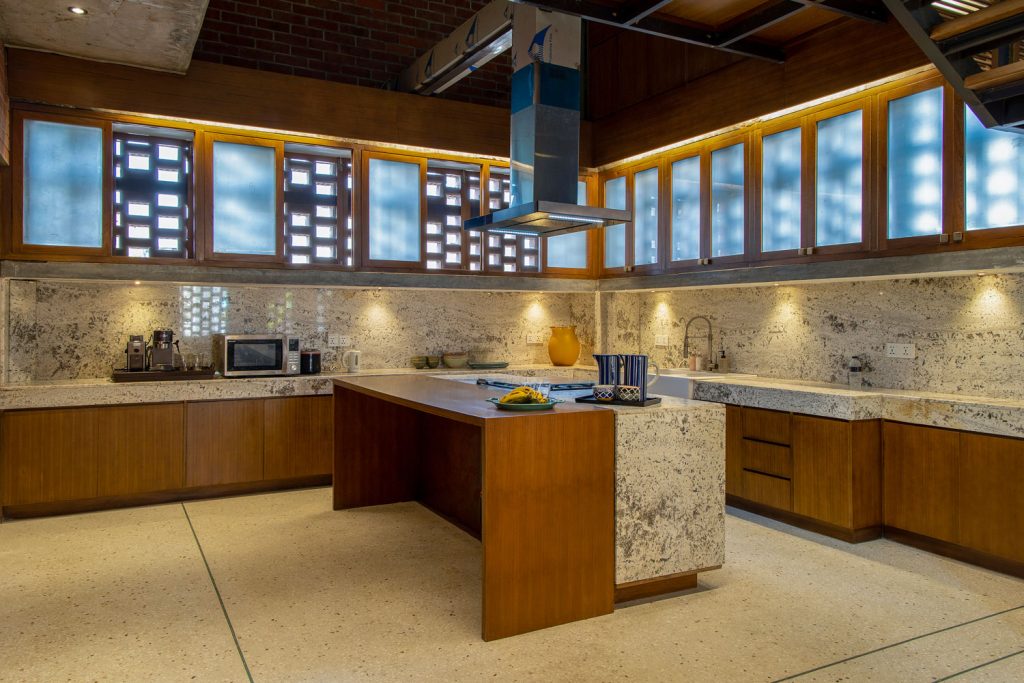
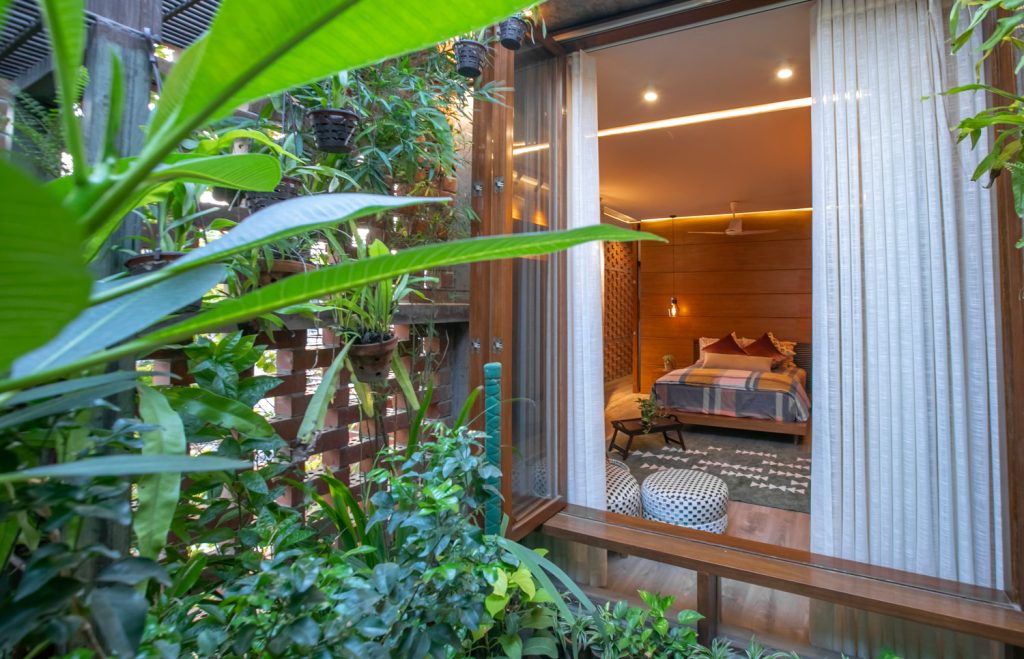
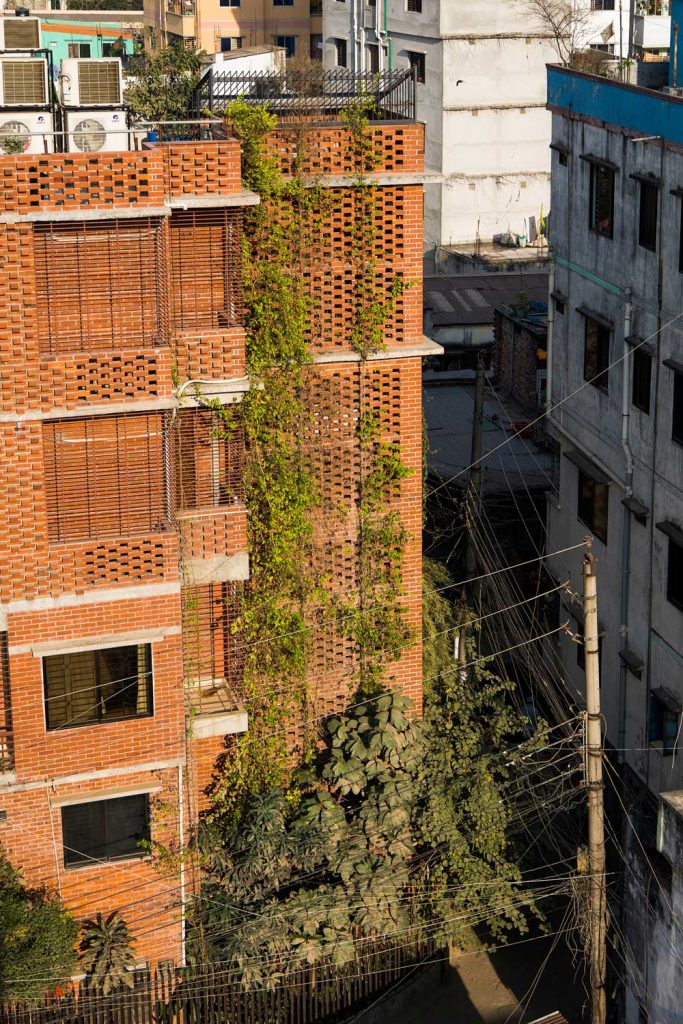
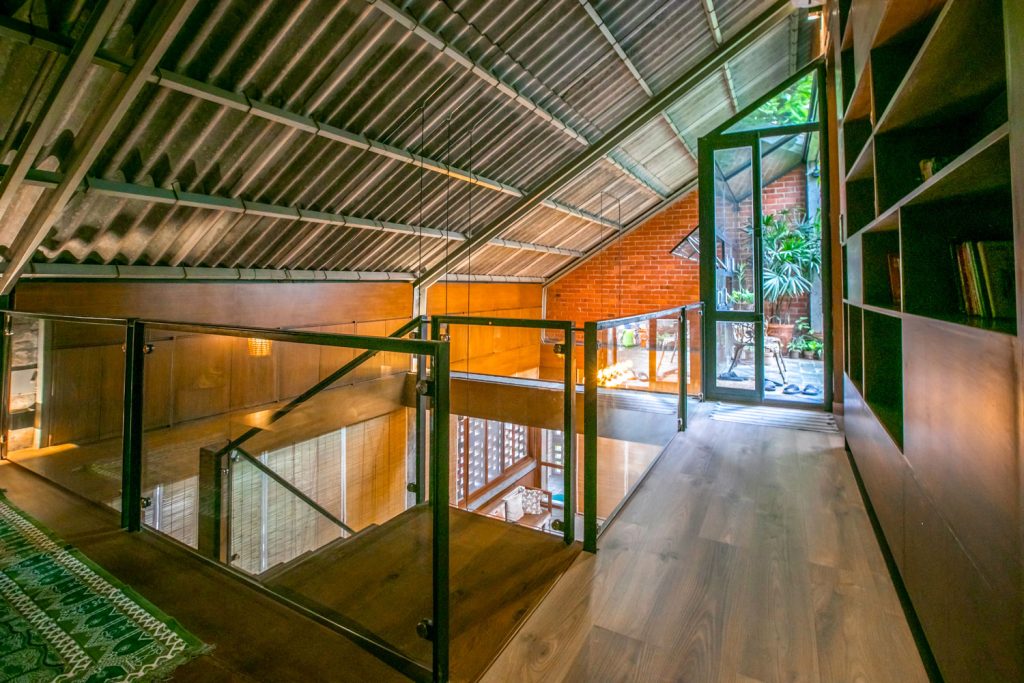
The project advanced whilst working alongside the surrounding area of the project with respect to the maintenance of the biodiversity and the already present ecosystems. One of the goals had been to ensure that, with time, the building became a part of the natural environment of the locale. Quamrul Hasan Pathan, with an aversion to the “modern look” retained by contemporary buildings, desired natural serenity and a somewhat unfinished aesthetic about his home. This is reflected in the stories and thoughts behind every individual element in the home, starting with the building materials, the psychological impact of the colour scheme and even landscaping. The primary structural components of the structure feature patterned brick walls, mosaic flooring and wood, used in support beams, and frames, among a plethora of other applications, incorporating the craftsmanship of multidisciplinary individuals.
Brick was chosen as a primary material as opposed to concrete, due to the object’s explicitly unique characteristic of graceful ageing.
The role of plants is underscored, graciously acting out its role as decor while simultaneously fulfilling the need for shade and spreading a pleasant aroma ubiquitously, creating a stimulus marker for passersby as the experience is ingrained in their subconscious, elevating the space itself. All plant life incorporated, Creepers, Rokto Kanchan, among others, are local species that play a harmonious role in the area’s ecosystem. The natural walnut colour of the wood was preserved to the extent possible. Notably, the space does not incorporate any striking colour or decor elements, relying on the fauna, flora and human components to add these facets, while the home itself is a background, acting as a silent observer to the biography of life.
The 900 sq ft space is artfully masked to appear larger through the open concept, strategic use of space and furniture placement. Small openings in the brick wall prompt sunlight to fall into the apartment in geometric shapes, which are mimicked in the wooden wall mouldings and patterned wood doors, furniture fabric, creating synchronous consonance.
The base of the project was previously a two-unit home with an attached roof on the top floors of an apartment building situated in a high-density area. The area, alongside the building itself, is a result of unplanned development, lacking a coherent grid. This brought forth several hindrances in the planning and realization of the design, taking around five years to reach completion. Even after execution, some bits of the area have been subjected to subtle damage and cracks; contentiously, these purposeful imperfections add to the ambient serenity of the residence.
Text by Zariat Mushfique Khan
Photography by Muhammad Bin Monzur, Zakaria Ahmed, Utsha Zaman, Raihan Sayeem
Navana Ascension, Gulshan
The Navana Ascension residential apartment is a thoughtfully detailed and well-planned project located in the calm locale of Gulshan. The apartment sought creative solutions to address noise and sun, shielding and protecting its inhabitants while offering light and efficient ventilation. The project is designed by Form.3 Architects and developed by Navana Real Estate Ltd.

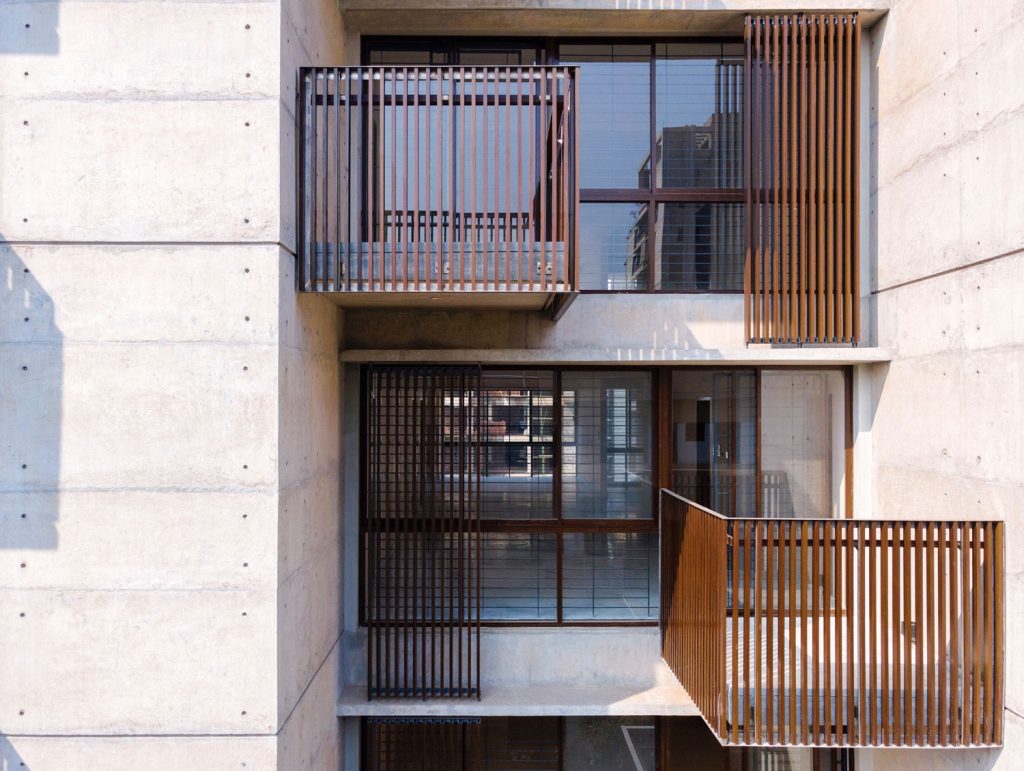
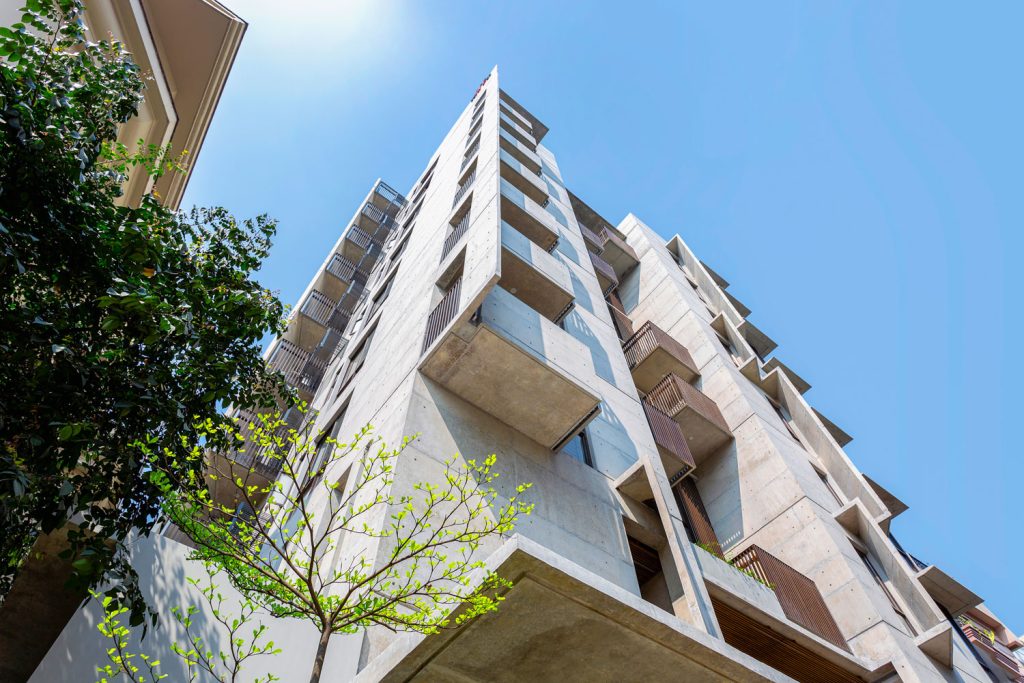
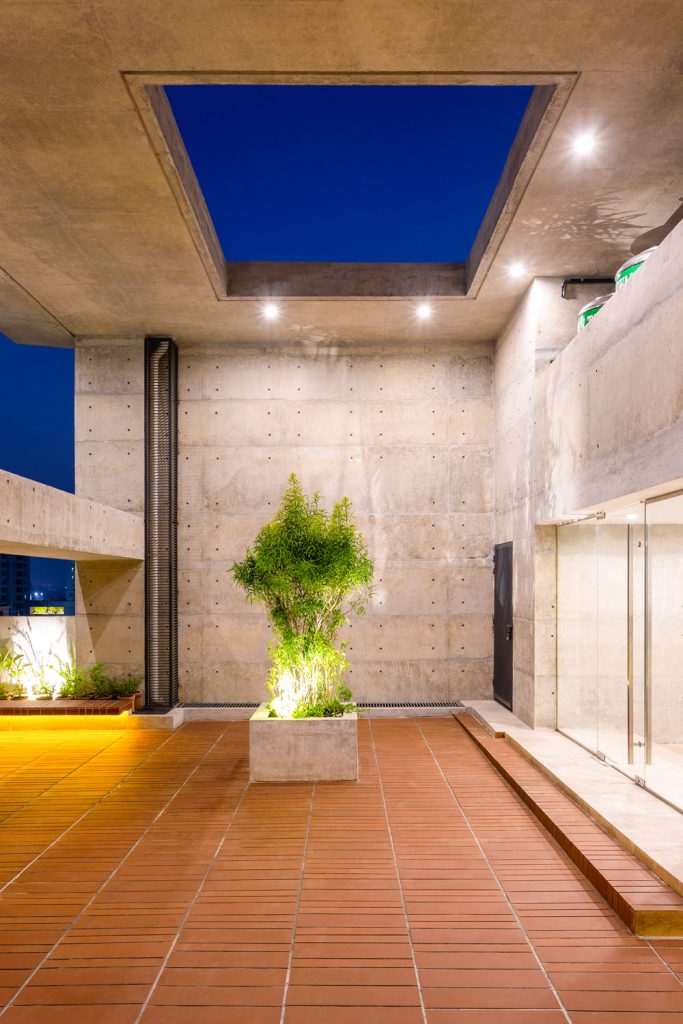
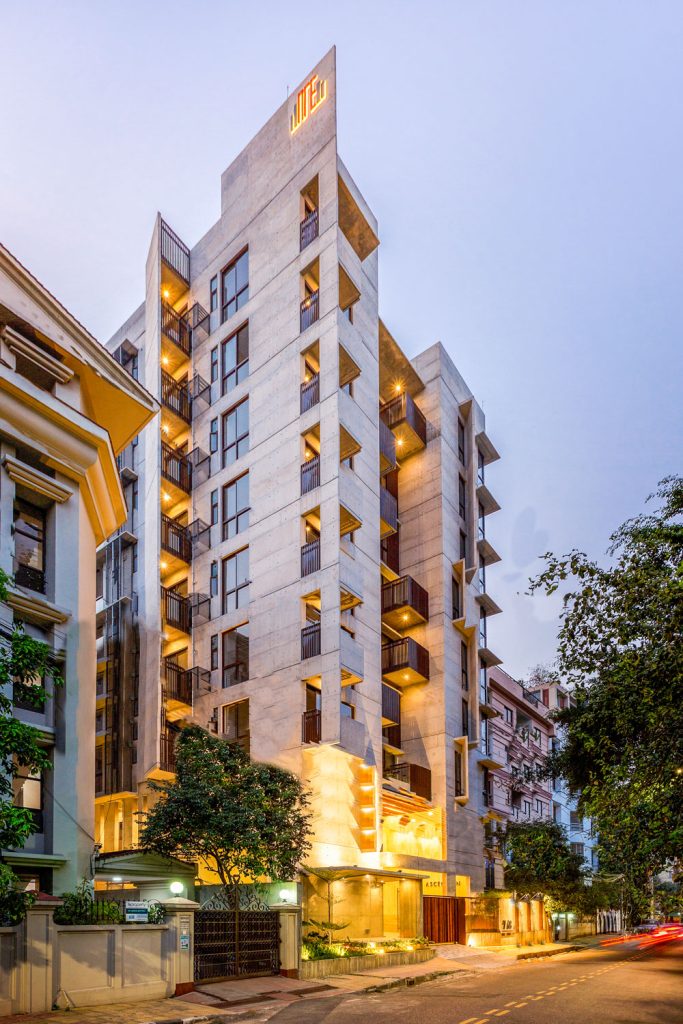
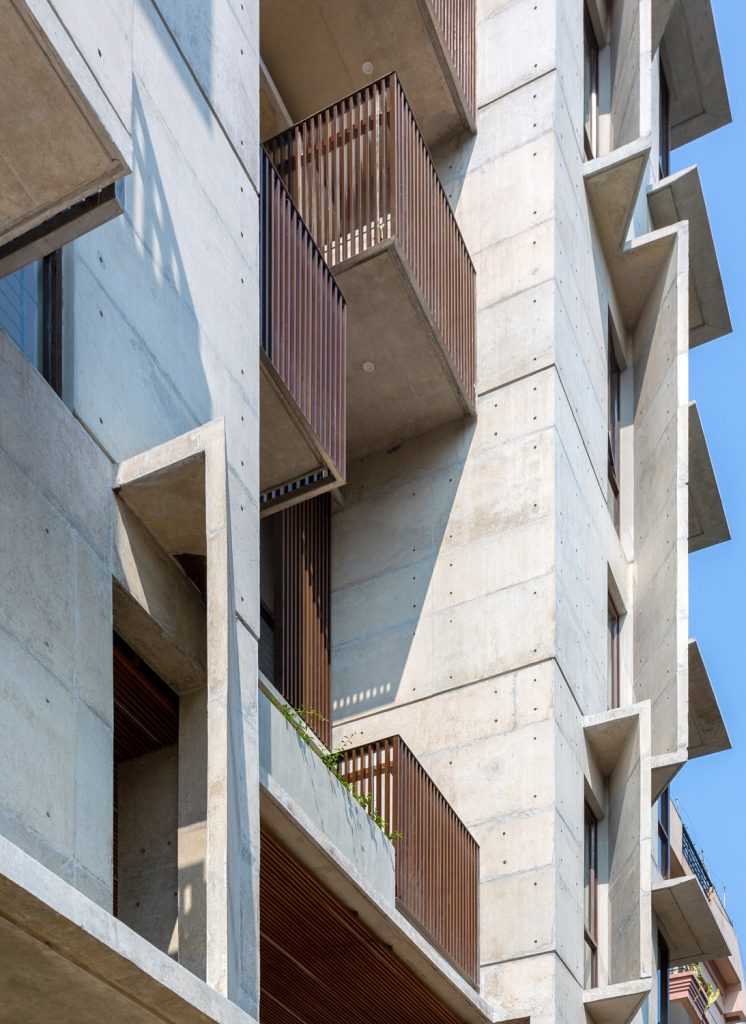

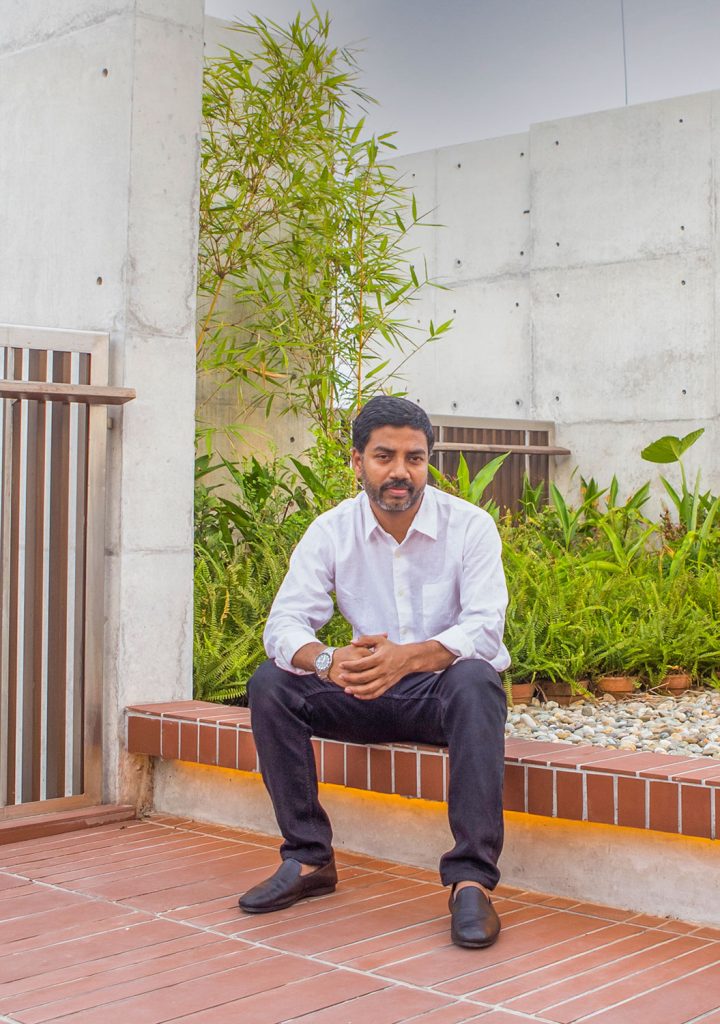
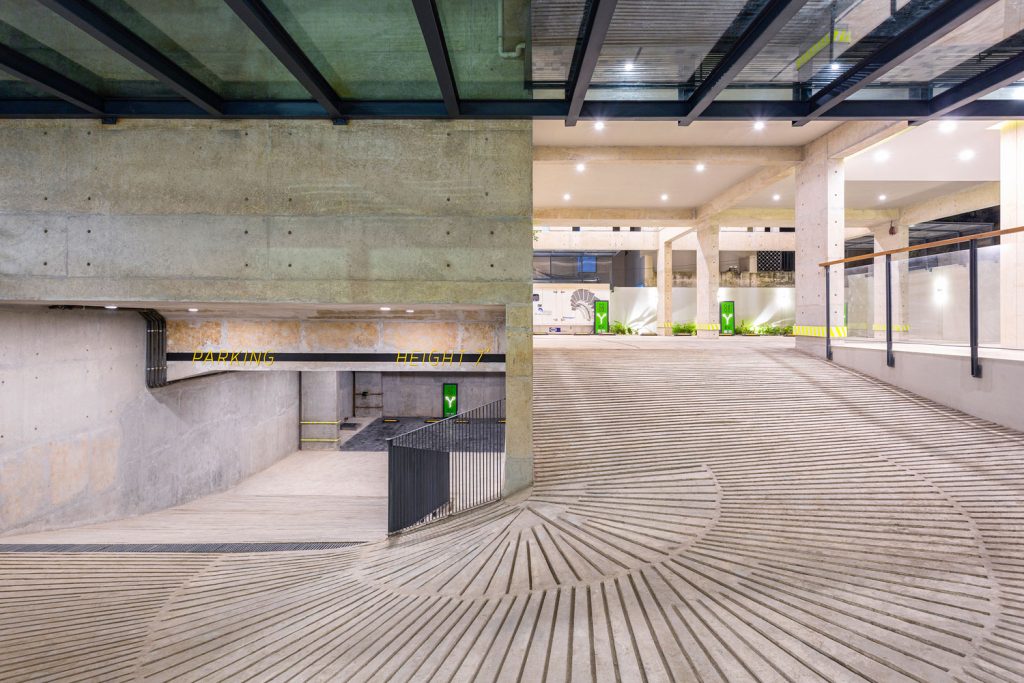
Along with Didarul Islam Dipu, Principal Architect of Form.3 Architects, the design team associates A K M Muajjam Hossain Russel, Sabiha Sultana Sara, Nayab Mahzabeen Chowdhury and Sakib Mortuza. The nine-storeyed building stands on a land of 6.68 katha, spanning seven apartments along with the basement, and the ground floor that serves as a community space. Each apartment is 3080 square feet composed of a clear and uncluttered layout.
The facades of the project is well articulated and forms a rhythm with the use of recesses and expressed material junctions, promoting a play of shadow and light.
Wooden balcony rails and the wooden screens refine the architectural language and humanize the appearance of the harder concrete material. “The apartment is bathed in natural light and air, brought in by the voids while the wooden screens shield the sun, and also permit a sense of privacy for the occupants, says Didarul Islam Dipu, principal architect of Form.3 Architects.
The project is entirely built in concrete with high-quality WMS rod and binding cement, while imported stones and marbles have been used throughout the apartment interior. Minute attention is given to the mechanical and plumbing sections by the design team, as such, no direct water is supplied from Dhaka Water Supply and Sewerage Authority (WASA) to the apartment, instead, water is driven through the water treatment plant and is cautiously processed with advance quality sanitary appliances that imply CPVC over GI or PVC to keep the water distilled for drinking and other uses. Another innovative feature of the apartment is the installation of a photovoltaic (PV) system. The residence has fourteen parking lots for the seven single-unit apartments, and each is connected to a photovoltaic (PV) charging system. “As Dhaka city is regarded as one of the polluted cities, it is the right time that we moved to advanced technologies that will aid in reducing pollution emissions and energy saving. And, therefore, introducing PV systems, and appropriate water system plant in projects will enhance the environmental quality and the living standard way ahead”, shares Chief Engineer, (Retd.) Brig. Gen. Md Syeed Anwarul Islam.
The rooftop is another essential part of the project that acts as a catalyst for social interaction. It is equipped with a barbecue space formed in a module, seating areas, and green oases inhibiting low-maintenance native plants. Green spaces in the yards and on the building roof of the ‘Navana Ascension’ could be another effective means of improving the quality of life both on the building scale and on the urban scale.
Text by Tasmiah Chowdhury
Photography by Noufel Sharif Sojol
Nazmir Bari, Chandpur
Set in a tranquil locale of an approximate three bigha land in Chandpur district, Bangladesh, the vacation house designed by architect Mohaimeen Islam, accommodates modern requirements and aesthetics while adhering to traditional roots. The project exhibits a concise and simplistic design approach, conforming to the local context, climate, and site-specific conditions. Built out of local materials and techniques, this project, ‘Nazmir Bari’ hence emphasizes the essence of solidarity and contemplation through an uncluttered and bold architectural expression.
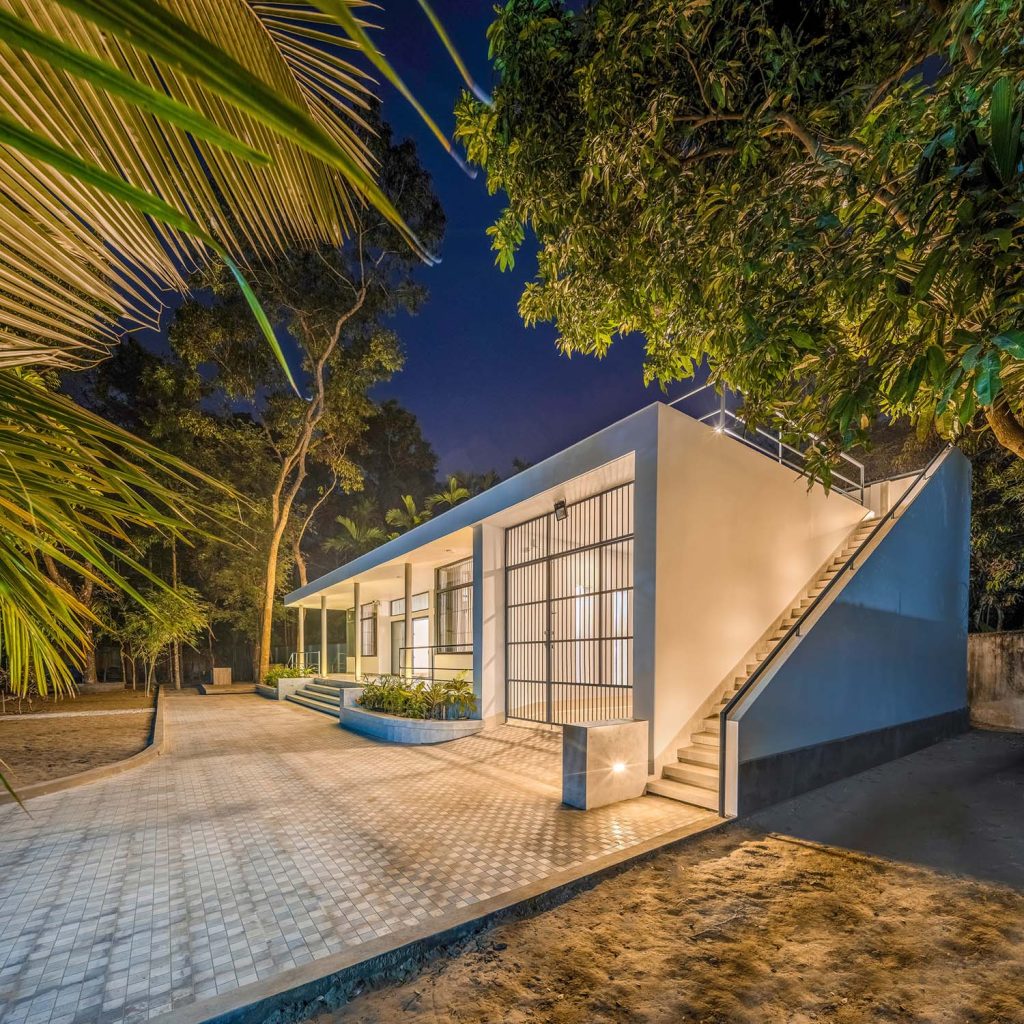
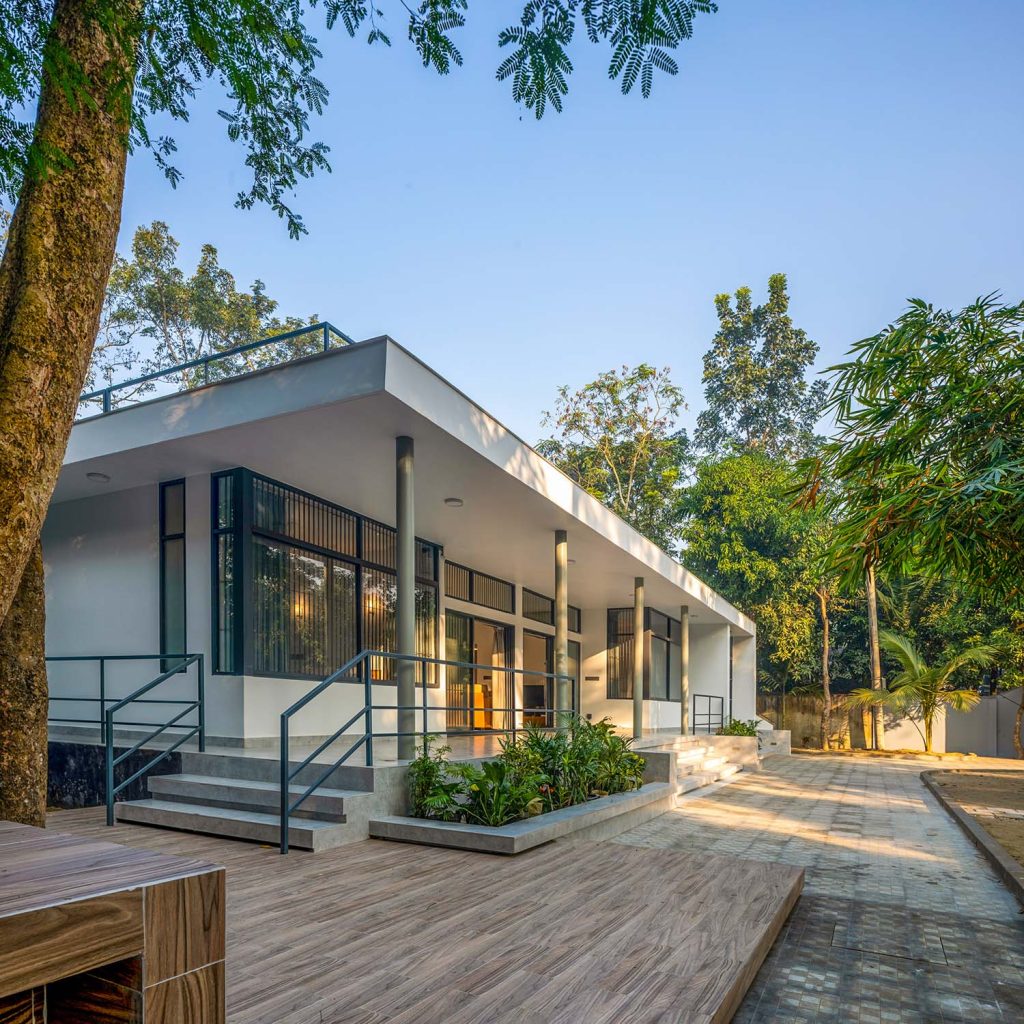
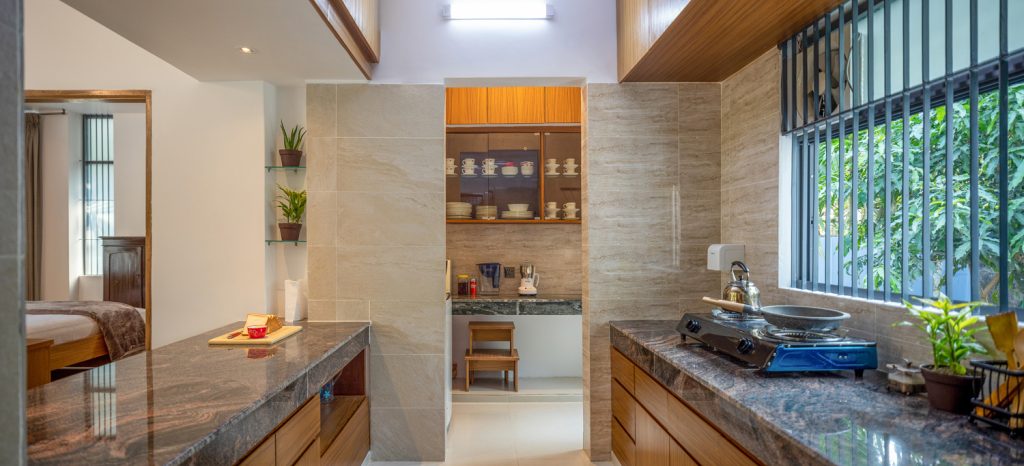
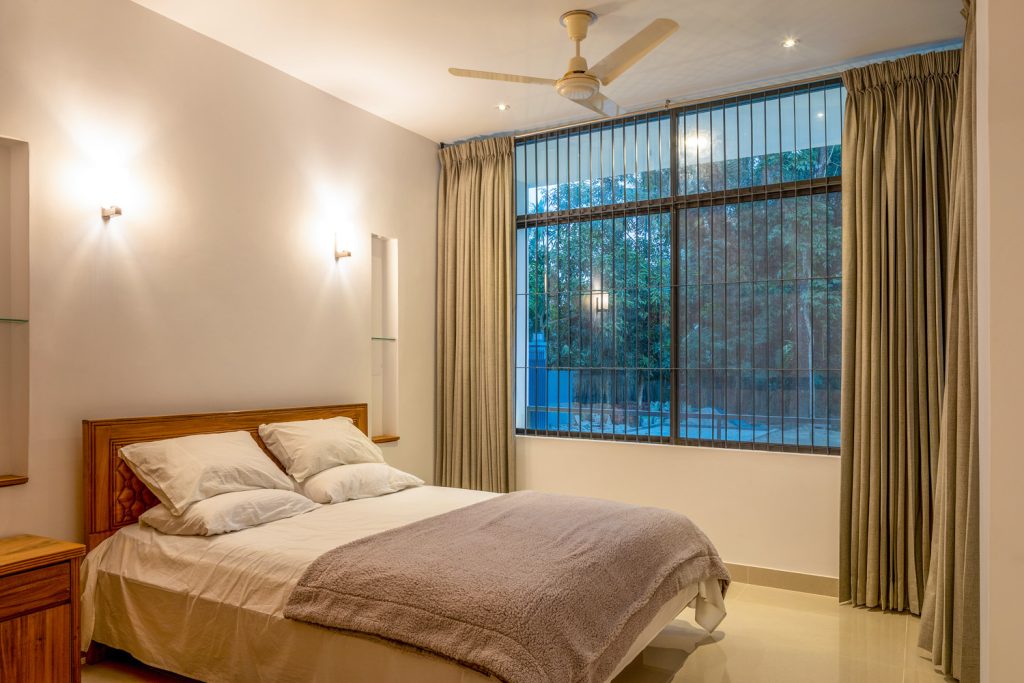
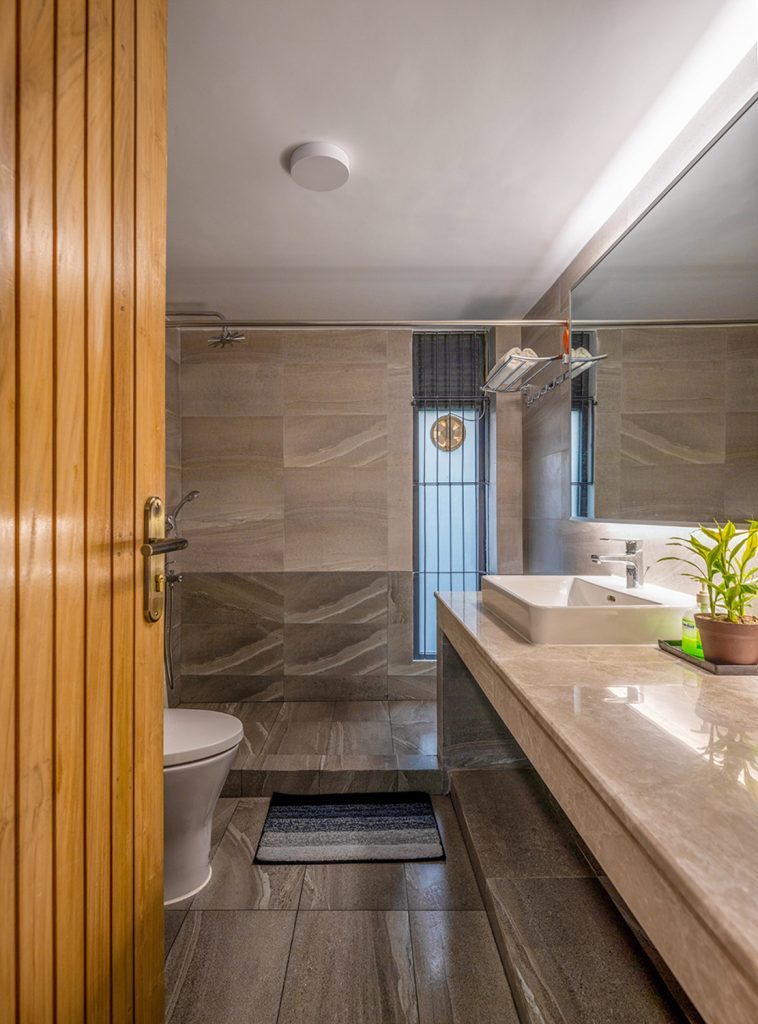
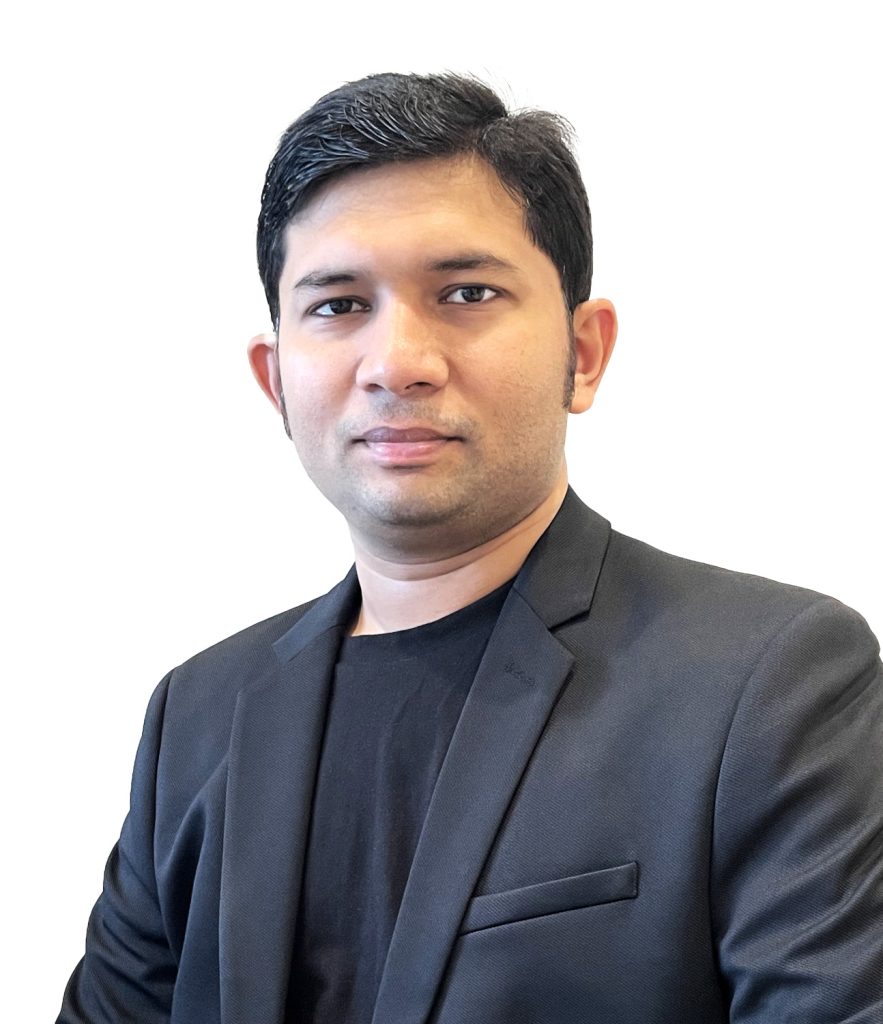
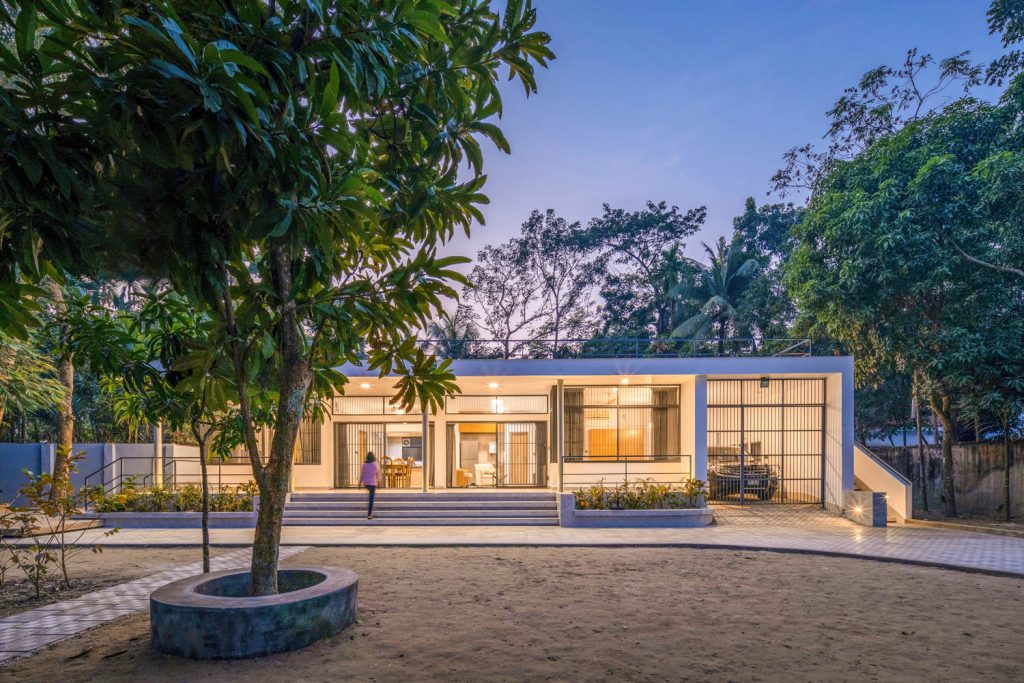
The three-bigha piece of land, of Nazmir Bari, has been inherited over generations; however, left abandoned for a long time, as the family migrated to the city. Experiencing several years of urban life, the client longed to return to his homeland, to enjoy his retirement, where he once lived and grew up.“He wanted to replenish and rejuvenate the rural experience but without compromising modern-life facilities”says architect Mohaimeen. “With passing time, the village life and its rural setting have transformed, largely driven by the effect of urbanization. Such change asserts a premise to redefine the village house conception, that can be appropriate to the current time while retaining the values of rural architectural features”, continuing. The site, in its origin, can be viewed as small forestry with a pond on the east and surrounded by a variety of trees, e.g. Rain, Shimul (Cotton), Karai and other fruit trees; some date 60 to 100 years old. Guided by such a natural setting, the house is purposefully positioned on the northern end which was originally vacant, leaving the dense tree zone unhampered.
In this project, the design initiates with a sympathetic response to rural architecture, as the elongated eastern veranda overlooks the widespread front yard – the ‘uthan’.
The veranda extends to the south, terminating on the outdoor deck, a place housing the drinking water deep-well, and occasionally used for cooking and eating. The uthan is also curated with a few seating platforms around the trees and a dedicated outdoor dining area. Traditionally, a uthan acts as the heart of rural architecture. Whether celebrating seasonal changes or simply cooking huge family dinners – such activities are often performed around the uthan; which is no different in this project. However, the concept of the ‘roof’ feature is negotiated and deviates from the traditional pitch-roof characteristic. “To drain off the water, a roof does not need to be pitched; though it may offer an iconic semblance. We chose a flat roof structure, making the roof-top usable for gardening purposes, incorporating proper drainage system”, shares architect Mohaimeen.
The design adapts a simple linear configuration, separating the served and service functions. The service block, placed on the west, comprises an open kitchen, a store room, a kitchen-veranda and other utilities, all acting as a thermal buffer from the western heat. The served zone comprises two bedrooms and a shared living and dining space; overlooking the uthan and the ancestral pond through an enlarged opening, that links the front veranda as an entry. All rooms are bathed in eastern light and southeastern air; brought in by large glass panelled windows, allowing plenty of natural light and fresh air to spill into the interior and maximizing the view of the vibrant landscape. The built-form hence acts as a silent enclosure to experience the enchanting landscape on the forefront, from within.
Photography By: City Syntax
Shaptak Insignia, Dhanmondi
For quite a few years now, it has become a common practice in Dhaka to adorn residential buildings with potted plants and call it a tribute to greenery. Shaptak Insignia breaks out of the lukewarm normalcy and embraces earth and all its vitality in its entirety. Located conveniently in Dhanmondi, the 2,100sqft residential building accommodates 18 apartments on a 10-Katha piece of land. The structure was designed by Nakshabid Architects, who knit comfort and usability in a soothing, environment-friendly package.
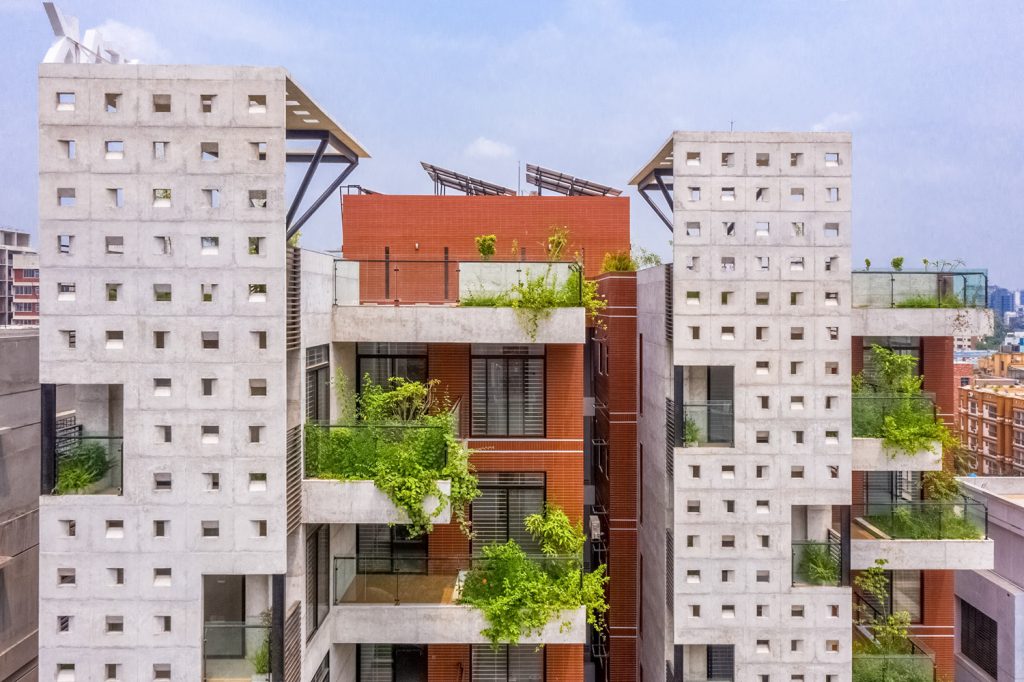
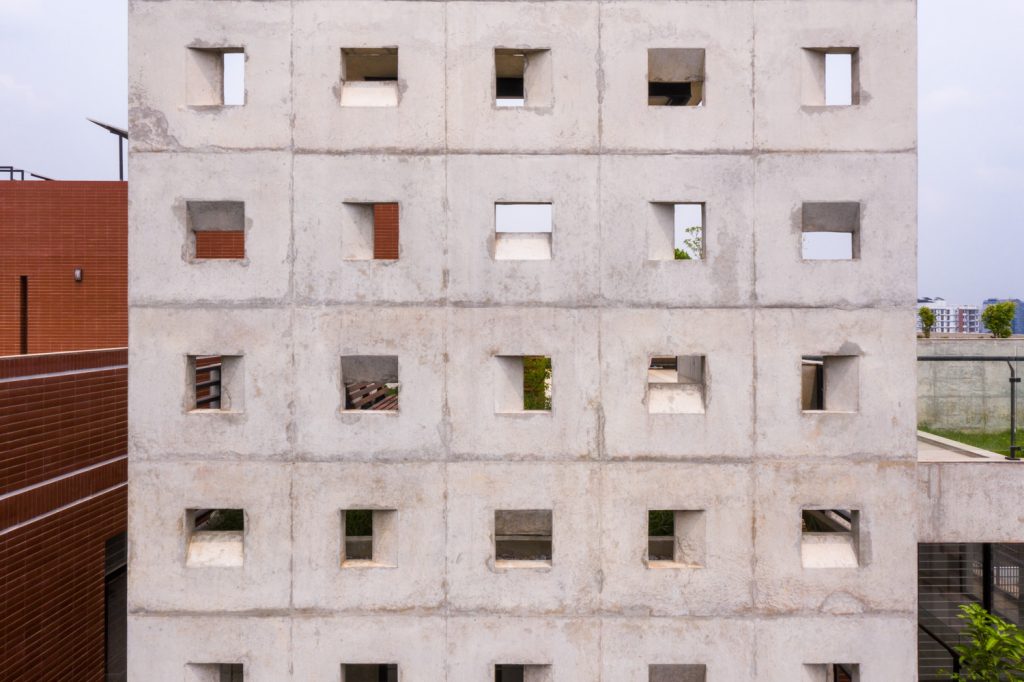
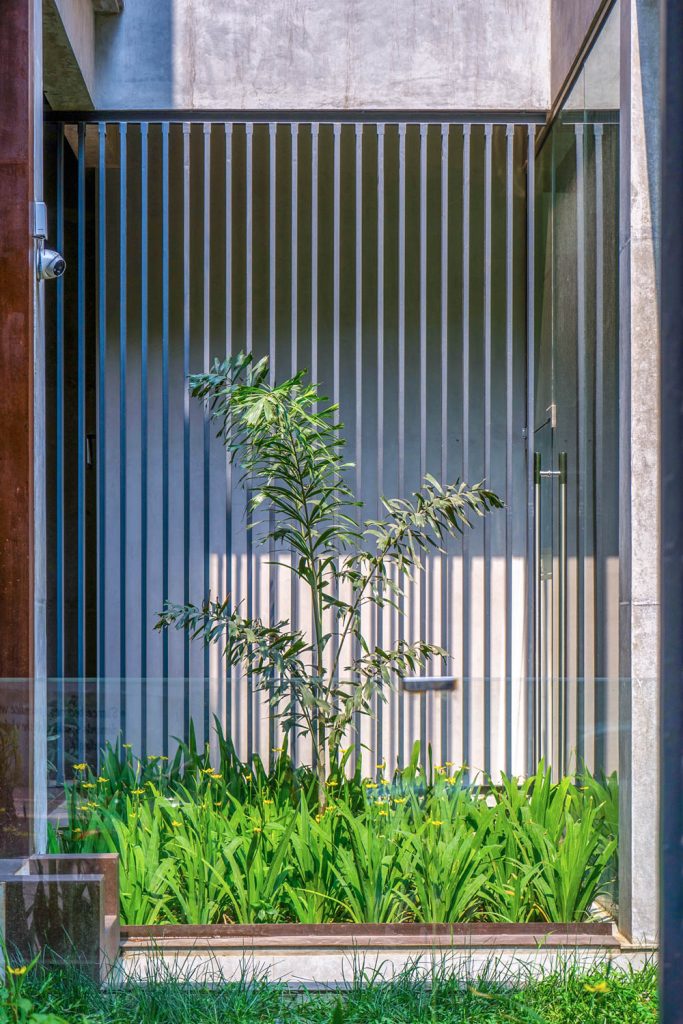
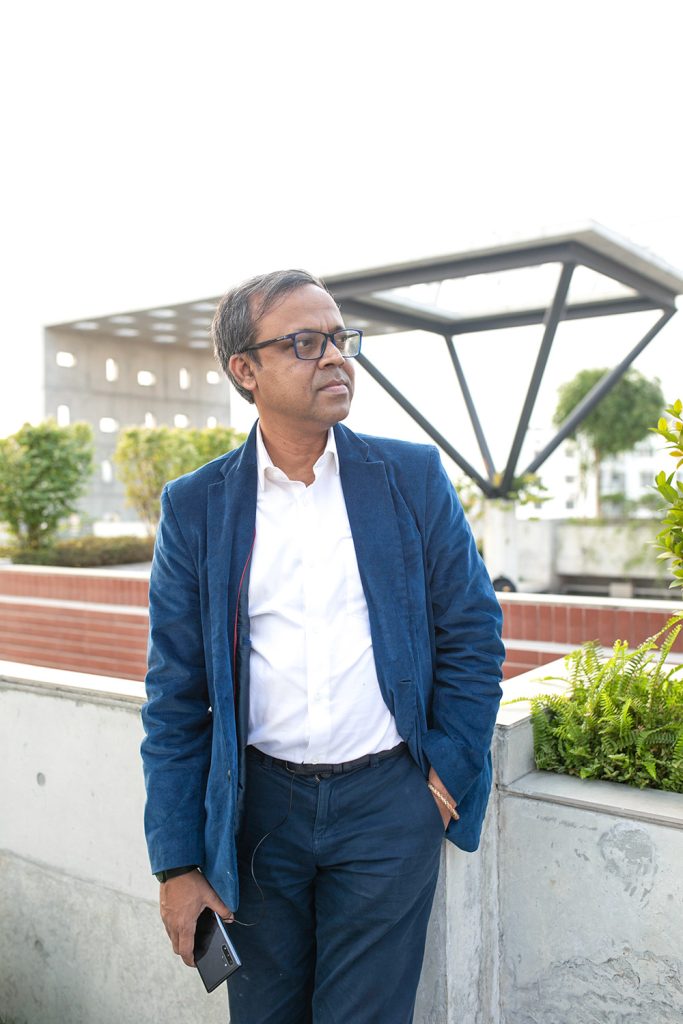
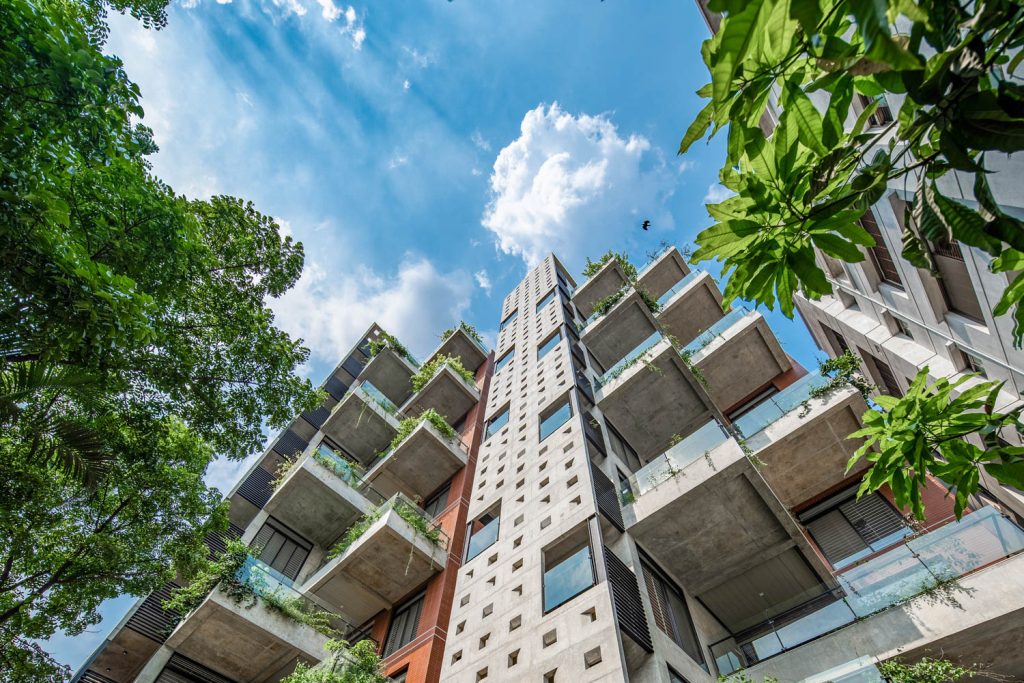
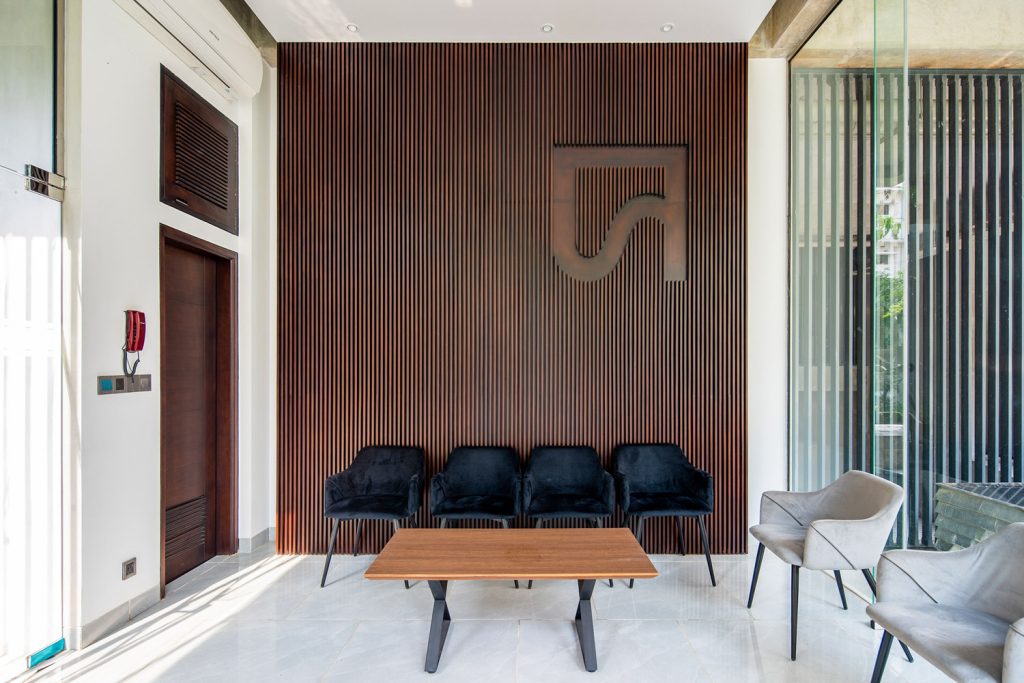
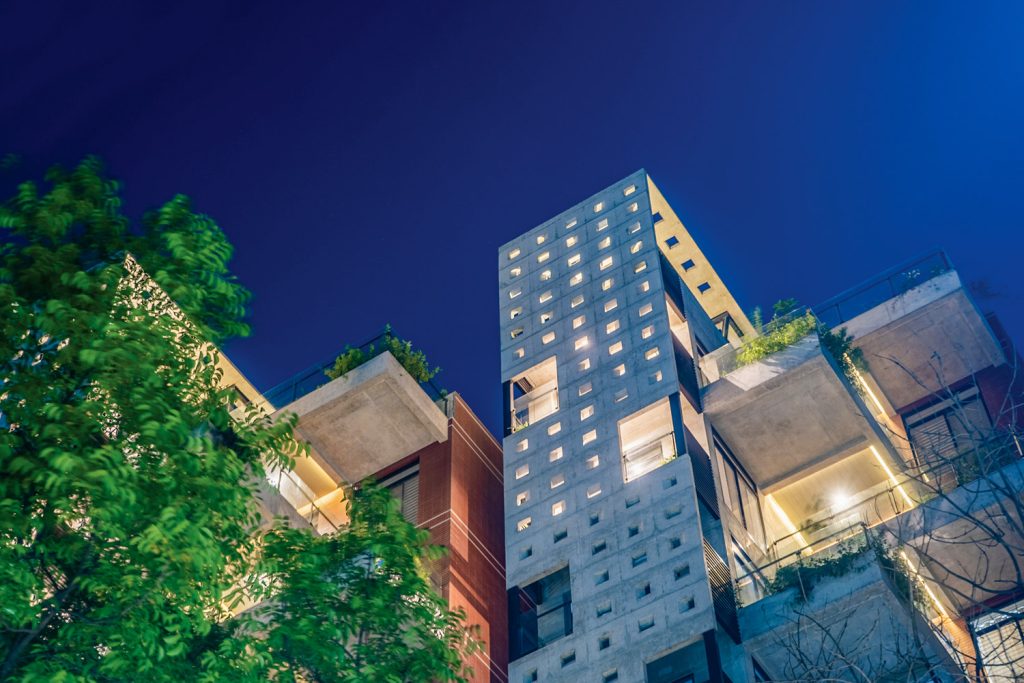
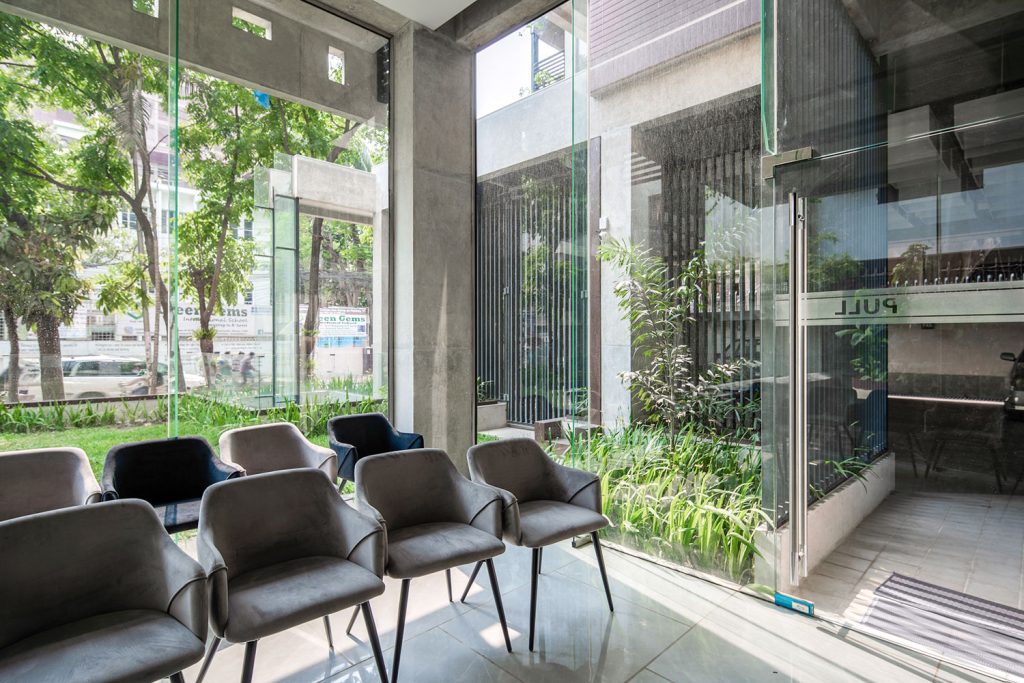
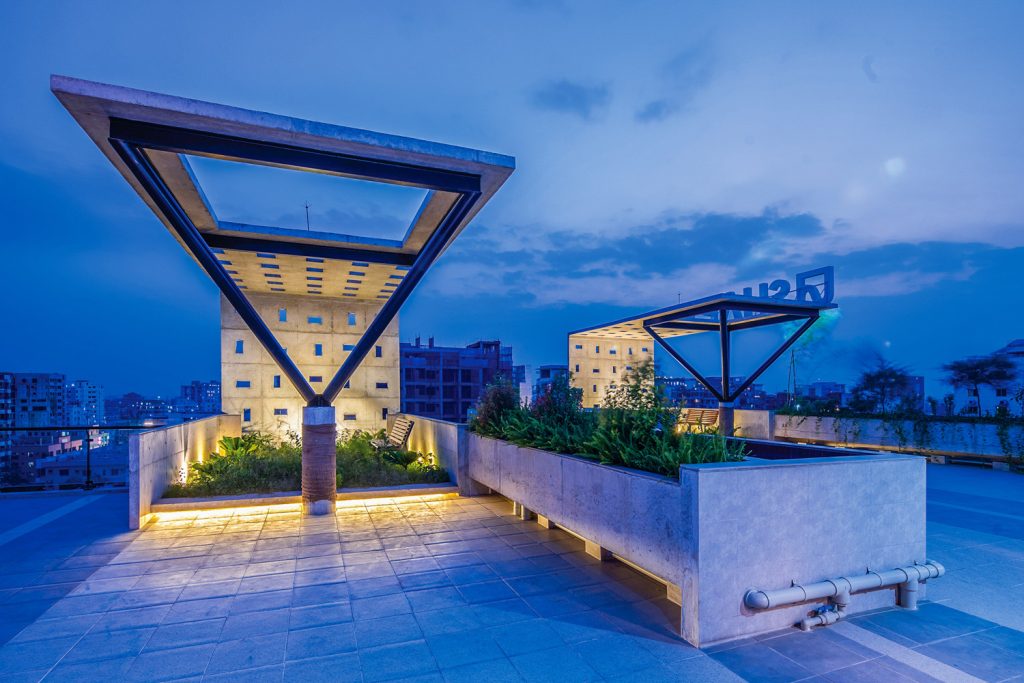
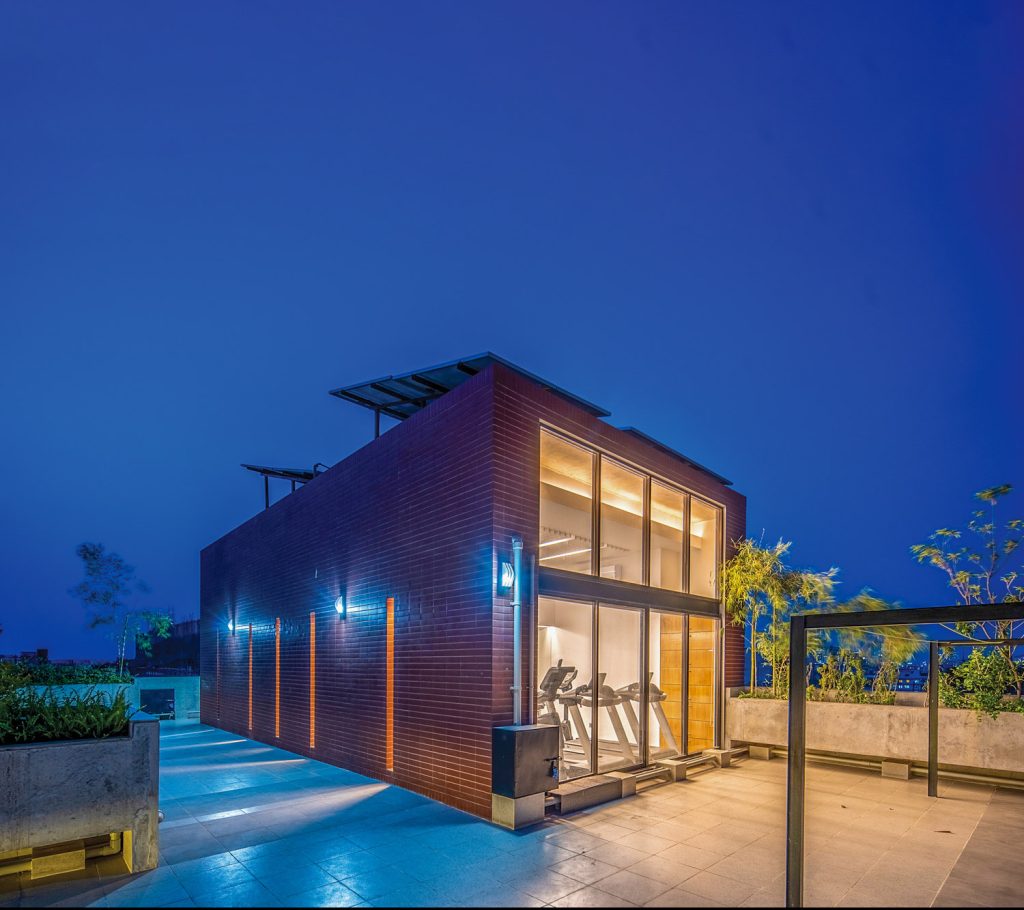
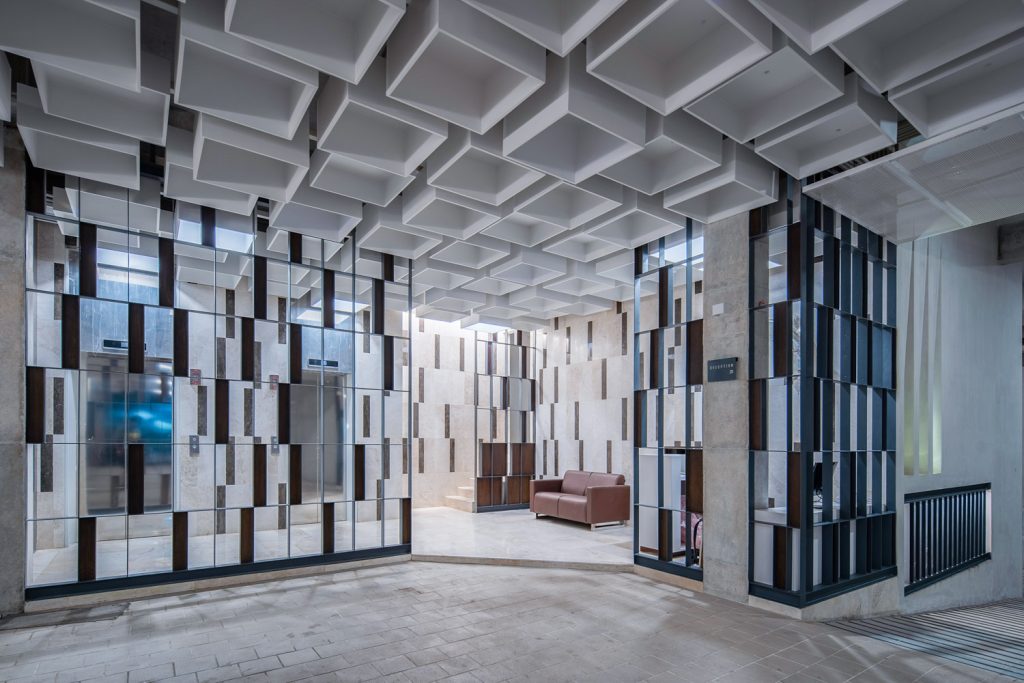
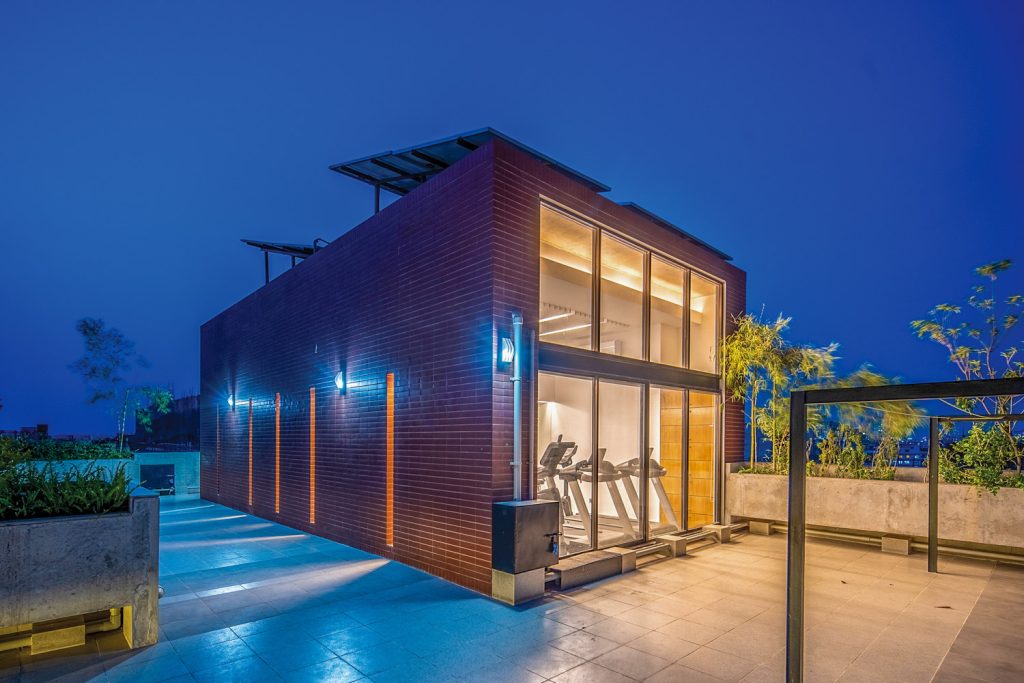
“There’s a fixed vocabulary for urban multifamily houses, you can’t really introduce many variations to it,” Ar. Bayejid M Khondker explains. “It’s like a fixed menu for a certain clientele– there’s not much scope to introduce wild ideas. Like a range of mass-produced shirts, we make buildings that would fit the needs of the majority.” The client for Shaptak Insignia also wanted something that would fulfil the needs of the residents. They offered some pointers on feasibility, and the architects designed the apartment complex with that in mind. Ar. Bayejid stated that the building was designed with the aim to optimize space. “We didn’t want to add design elements that were non-performative and merely ornamental. Comfort is the primary focus here. Additionally, we made maximum use of natural resources in the design,” he said. The design could’ve followed the norm and kept the ground floor solely as a parking space. Instead, it sent most of the parking spaces to the basement, and that left about one-fourth of the ground floor to be dedicated to a miniature grassy field. There’s also a water body that collects rainwater to add serenity to the scene.
We tried to make the first look soothing. When you enter the building, instead of tiring rows of cars, you would be welcomed by natural elements at eye level,” the architect explained. There’s something resembling a garden at this level, made up of plants, creepers, and the water body. The design team has also installed large stretches of earth, deep enough for growing up to 20 ft trees on the staggered balconies. “There’s also scope for installing potted plants,” he added. But the stretches of the earth are the main attractions of this design. Once the plants and creepers are grown fully, they would hang down and add another layer of privacy for the residents. To tackle the heat, the roof also includes two large patches of planting space. Perhaps the most notable feature of the design- two screens made up of square-patterned lattices shroud the front of Shaptak Insignia’s exterior in a bid to provide both privacy and respite from the oft present heat in Dhaka.
The screens also turn into a canopy and add the provision of permeable shade up on the roof.
Focusing on the livability of the apartment complex, the architects tried to let go of extra finishing. As the Shaptak Insignia is west-facing, several design elements work to prevent direct sunlight from entering the structure. In addition, the design also creates a path for the southern air to flow through the dining space of each apartment, and keeps down the heat using natural resources.
Text by K N Deya
Photography by Maruf Raihan
‘Urban Legacy’ Residential Apartment
On the south-eastern edge of Dhanmondi Lake, a stature of brick stands profoundly as a unique and iconic landmark. Designed by Nakshabid Architects, the ‘Urban Legacy’ multi-residential project is one of their noteworthy designs that is located in Dhanmondi on a 10-Katha piece of land with gracious views of the Dhanmondi lake.
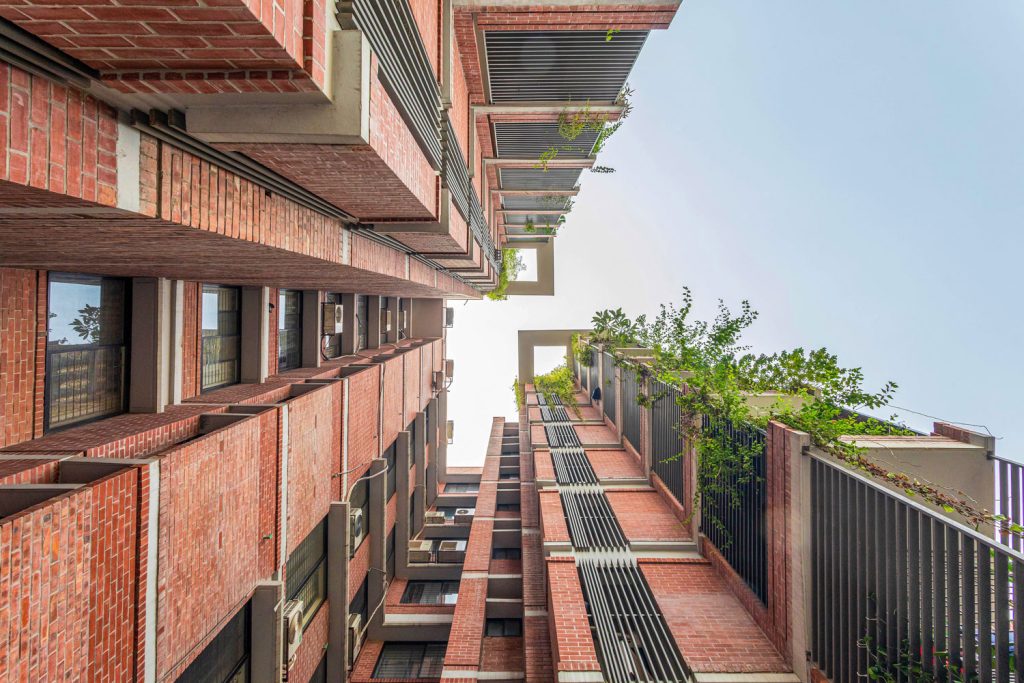
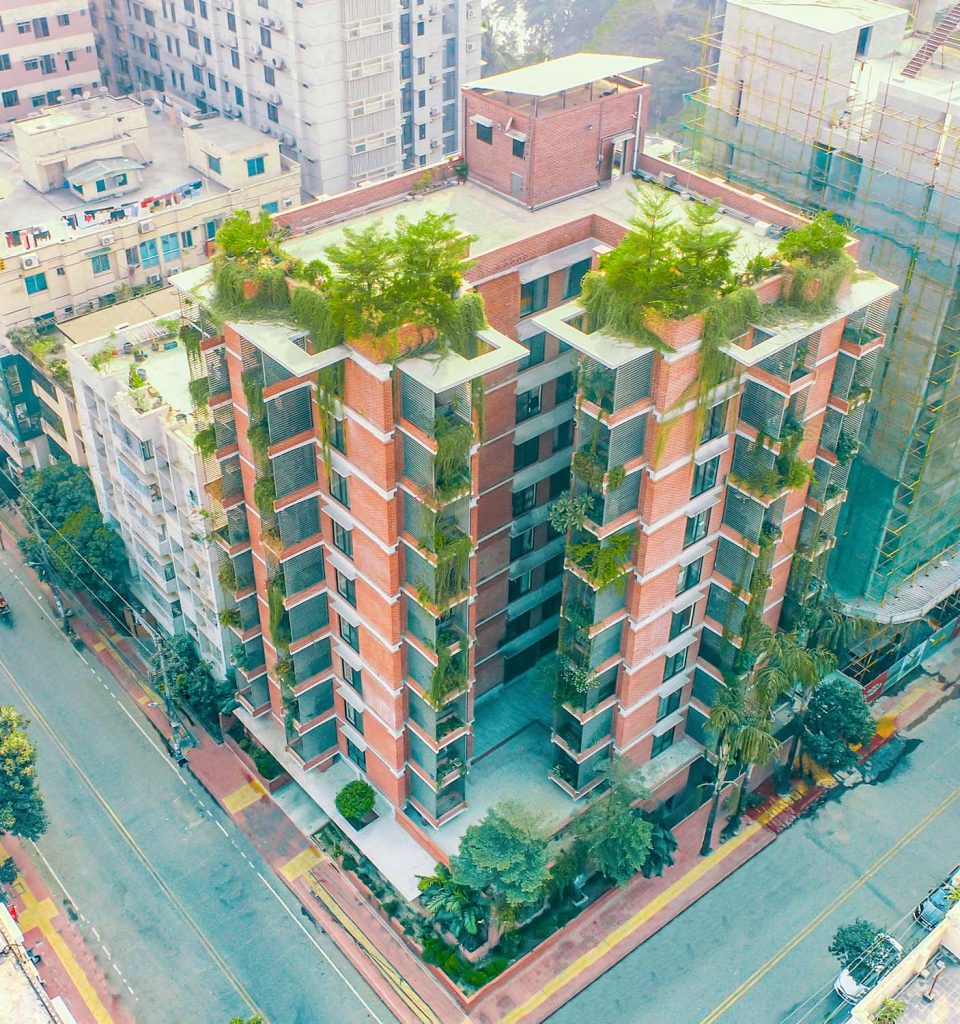
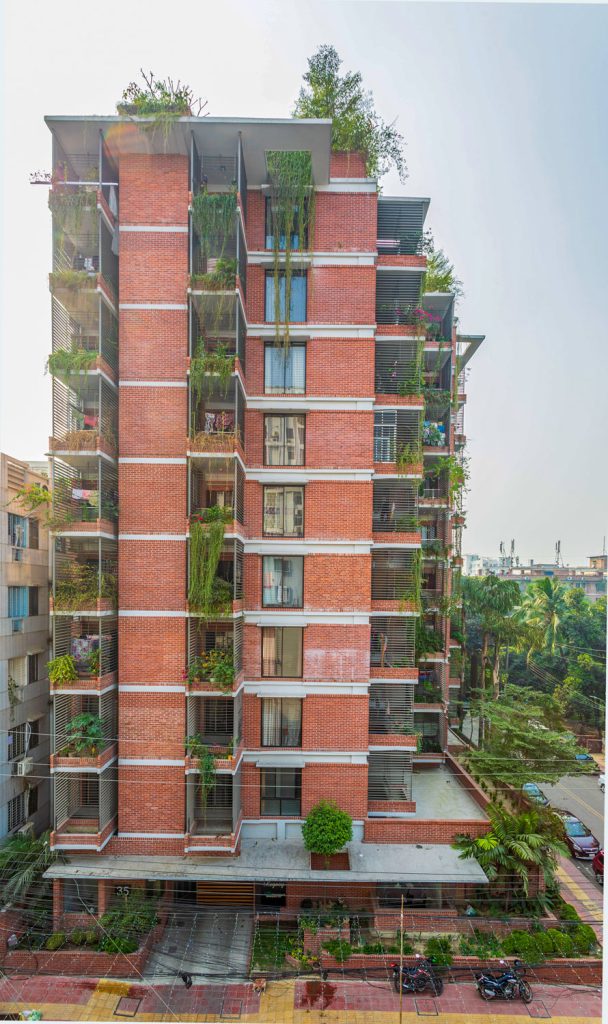
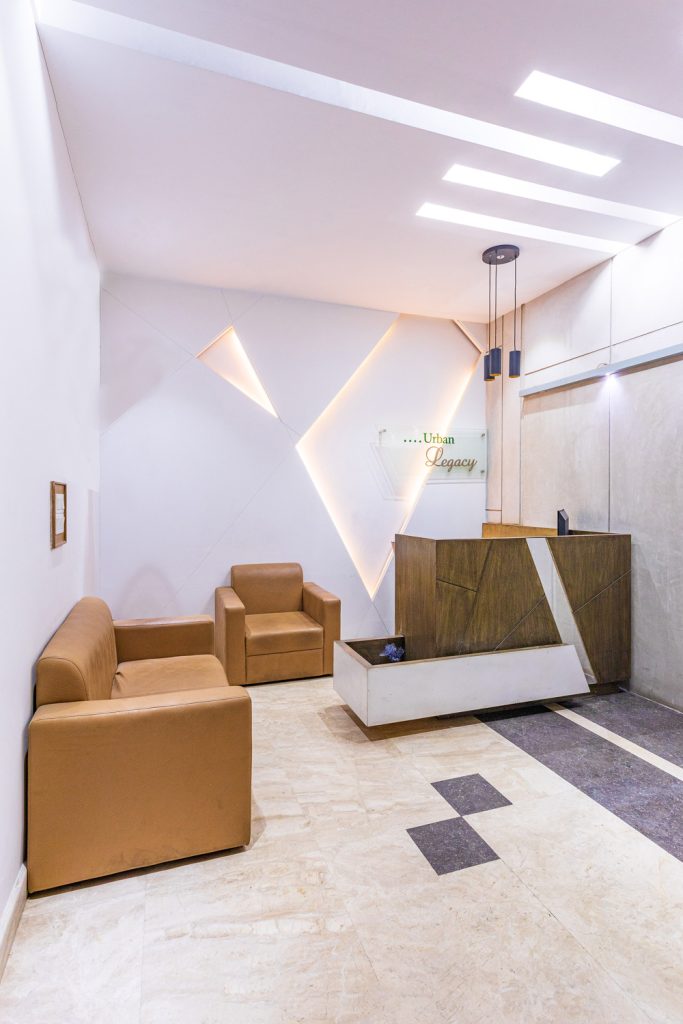
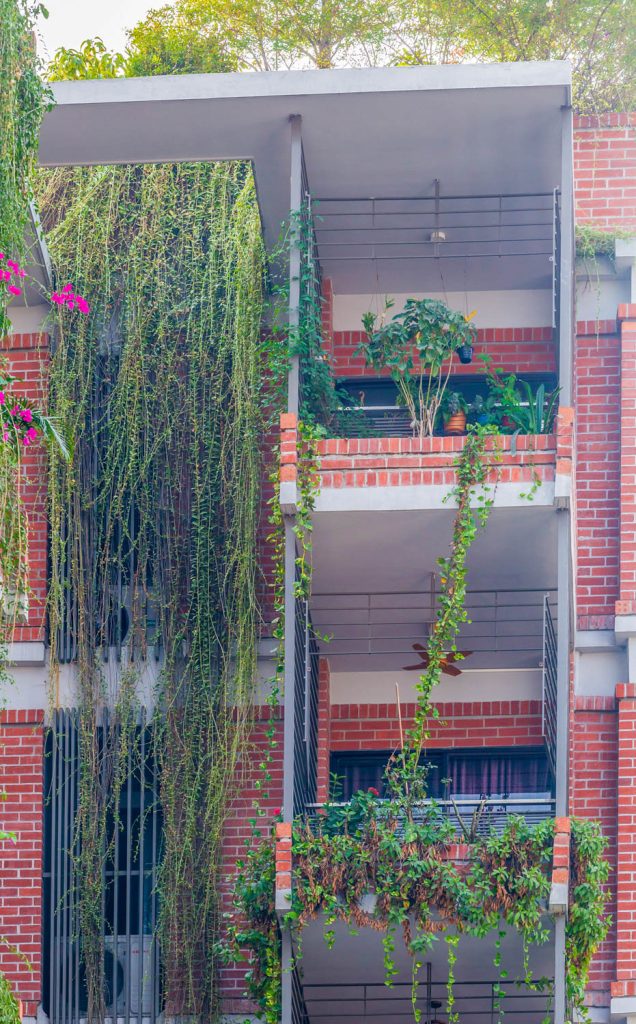
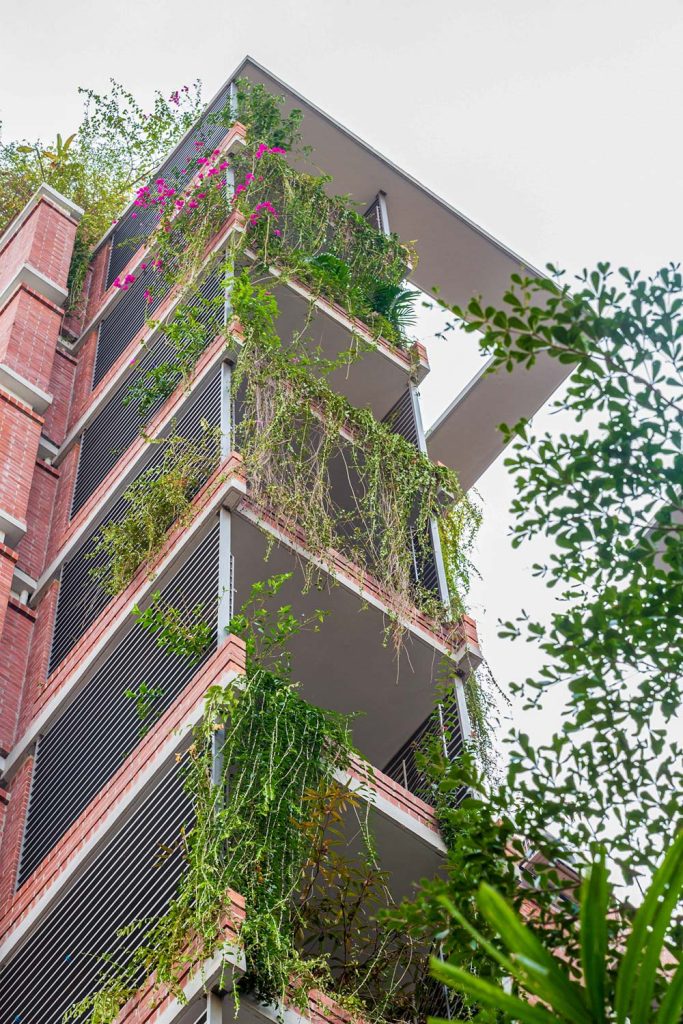
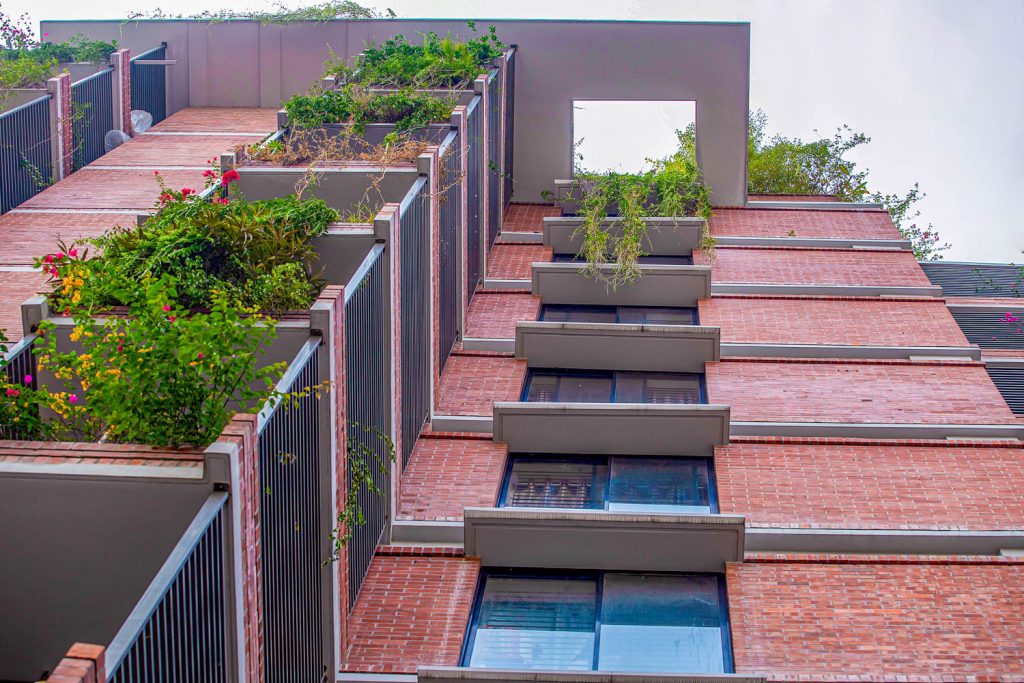
With 18 apartments of approximately 2100 square feet, the building was completed in early 2021, requiring four years for construction.
The remarkable features of the building are focused on durability, longevity, and building material.
Real estate building designs have evolved over time, and lately, concrete and brick have been adopted as building materials for longevity, which helps reduce yearly maintenance, instead of plaster paint. Since the building has no plaster finish, one of the main challenges in the construction of the Urban Legacy was achieving the last outlook of well-burnt brick of premium quality and colour. While describing the ideas and concepts behind the project, Ar. Bayejid stated that “using brick as the principal material as a building envelope was to assure the design of a sustainable, breathing building. Integrating greenery, contrasting with the site surroundings of Dhanmondi, was a considerable concept here. Moreover, natural light and ventilation were ensured in the design.”
The units designed for the building were quite generic but ingeniously thoughtful. In most of the apartments in Dhaka, the dining space is located in the center of the apartment, where there is usually no scope for natural light to reach. Yet, contextually the homesteads in our rural areas have always had the concept of an open central space “Uthan – Courtyard” which is dedicated to gathering and dining activities of the family. Even though that concept is difficult to achieve for an apartment in an urban setting, the presence of openness and natural light can be ensured by the designer, which is represented as a promising concept for this building. Besides, the bedrooms were located on the northeast side of the building, facing the road, and louvers were introduced in the façade for environmental and strategic purposes.
The amenities for the residents include a multipurpose hall and a well-designed roof. An extended overhead roof was considered to protect the building from heat gain as well as to make it sustainable. Providing scenic views of Dhanmondi Lake, the roof is designed as a retreat for the residents to hold gatherings and events.
Architect Bayejid Mahbub Khondker designs environment that interact with the societal values and demands of a particular time and place. He states, “Everything we see around us except nature defines a blended architecture that is man-made and always evolving with time.” Describing his ideologies of design, he adds, “Whatever profession may be, the basic essence of a person lies in his efficiency and altruism. A building design should be similarly sustainable and self-sufficient as well. Natural resources such as sunlight, water, and air are like assets to us and must be given priority while designing any space. Moreover, it is extremely important to ensure the needs and comforts of a client instead of forcing our artistic designs upon them.”
Text by Samira Ahsan

